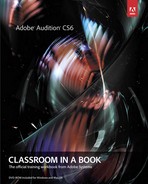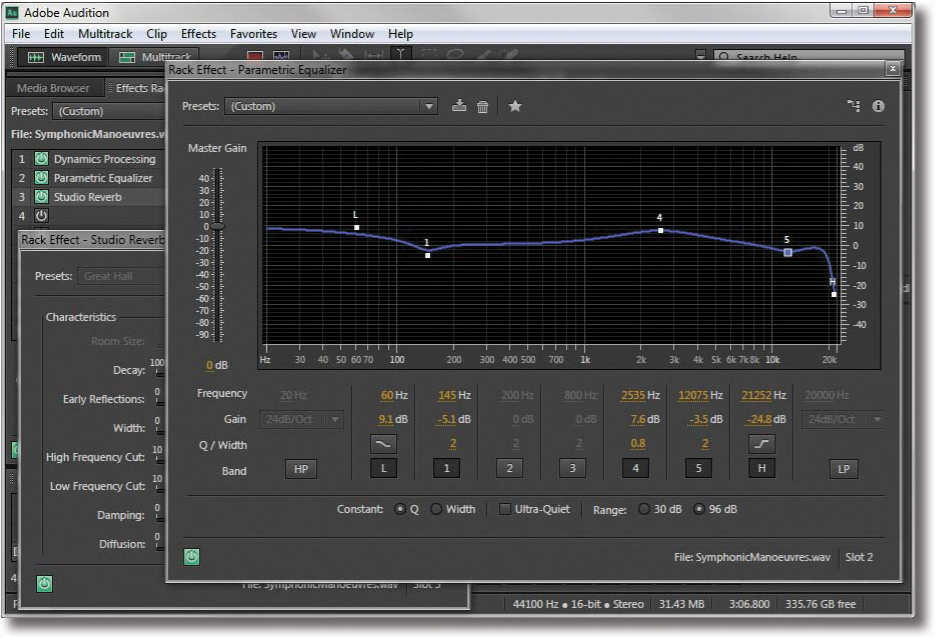4. Signal Processing
Use signal processors to “sweeten” the audio in multiple ways: fix tonal balance, alter dynamics, add ambience or special effects, and much more. Draw from the extensive collection of effects included in Audition, or use third-party plug-in processors.
Effects basics
Effects, also called signal processors, can “sweeten” audio as well as fix problems (such as too much treble or bass). They are the audio equivalent of video effects, like contrast, sharpen, color balance, light rays, pixelate, and so on. In fact, sometimes audio engineers even use similar terms, like “brightness,” to describe increased treble.
Adobe Audition includes a wide range of effects. Most can work with the Waveform and Multitrack Editors, but some are available only in the Waveform Editor. There are three main ways of working with effects, which are available in the Waveform and Multitrack Editors.
• The Effects Rack allows you to create a chain of up to 16 effects, which you can enable or disable independently. You can add, delete, replace, or reorder effects. The Effects Rack is the most flexible way of working with effects.
• The Effects menu allows you to select an individual effect from the Effects menu bar and apply it to whatever audio is selected. When you need to apply only one specific effect, using this menu is quicker than using the Effects Rack. Some effects are available in the Effects menu that are not available in the Effects Rack.
• The Favorites menu is the quickest but least flexible way to work with effects. If you come up with a particularly useful effects setting, you can save it as a Favorite preset. The preset is then added to the list of Favorites you can access with the Favorites menu. Selecting it applies that preset instantly to whatever audio is selected; you cannot change any parameter values before applying the effect.
This lesson initially covers using the Effects Rack, which introduces the majority of effects. The second section covers the Effects menu and discusses the remaining effects that are available only via the Effects menu. The final section describes how to work with presets, including Favorites.
Using the Effects Rack
For all lessons involving the Effects Rack, it is best to use the Default workspace. From the File menu, choose Window > Workspace > Default.
1. Choose File > Open, navigate to the Lesson04 folder, and open the file Drums110.wav.
2. Click the Transport Loop button so the drum pattern plays back continuously. Click the Transport Play button to audition the loop, and then click the Transport Stop button.
3. Click the Effects Rack tab, and drag the panel’s lower splitter bar downward to extend the panel to its full height. You should see 16 “slots,” called inserts; each of which can hold an individual effect and also includes a power on/off button. A toolbar is located above the inserts, and meters with a second toolbar are below the inserts.
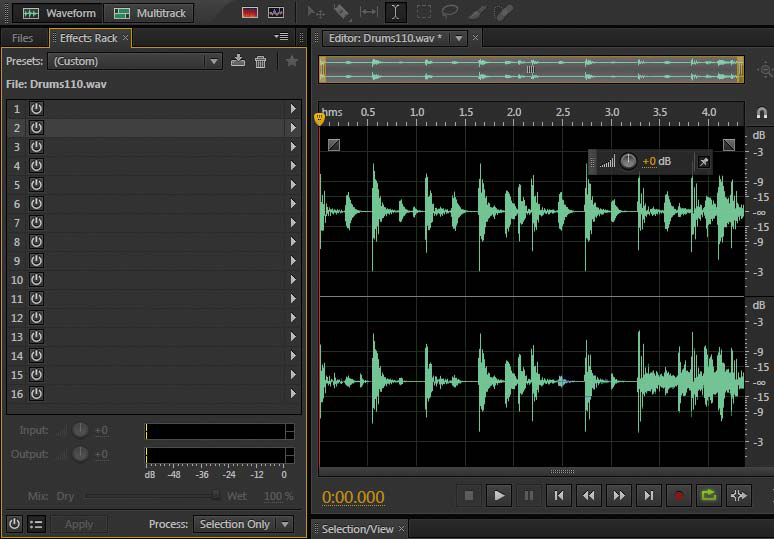
4. Before exploring individual effects, look at the individual effect’s inserts. Although you can’t see any graphical connection among them, the effect’s inserts are in series, meaning that the audio file feeds the first effect input, the first effect output feeds the second effect input, the second effect output feeds the third effect input, and so on until the last effect output goes to your audio interface.
Note
Effects do not have to go into consecutive inserts. You can leave empty inserts between effects and place effects in these inserts later.
5. To add an effect to an insert, click the insert’s right arrow and choose an effect from the drop-down menu. For the first effect, choose Reverb > Studio Reverb. Inserting an effect turns its power button to “on” (green) and opens the effect’s graphic user interface. You may need to move the effect’s graphic user interface to load more effects. For the second effect, similarly choose Delay and Echo > Analog Delay.
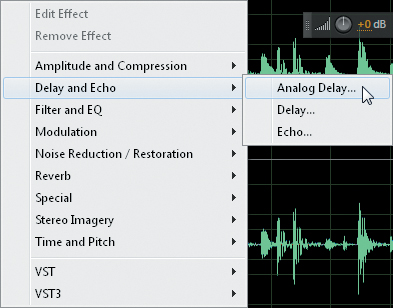
6. Turn off (bypass) the Analog Delay effect by clicking its power button. Press the spacebar to begin playback, and then turn the Studio Reverb insert’s power button on and off to hear how reverb affects the sound.
7. Click the Rack Effect – Studio Reverb graphic user interface window to bring it to the front. Press the spacebar again to stop playback.
8. When playback is stopped, you can choose an effect’s preset. Click the Studio Reverb’s Presets drop-down menu, and select Drum Plate (Large). Begin playback.
You’ll hear a more pronounced reverb sound. Note that the effects window has an additional power button in the lower-left corner to make it easy to bypass/compare the processed and unprocessed sound.
9. Click on the Analog Delay effect graphic user interface to bring it to the front, and then turn on its power button.
You’ll hear an echo effect, but it’s not in time with the music.
10. To make the delay follow the rhythm, double-click in the Delay parameter’s numeric field, type 545 in place of 200, and then press Enter. The echoes are now in time with the music. (Later in this lesson we’ll explain how to choose rhythmically correct delay times.)
Keep this lesson open as you continue.
Removing, editing, replacing, and moving an effect
Rather than present a structured exercise, try the various bulleted options that follow to see how they work. After each action, choose Edit > Undo [name of action] or type Ctrl+Z (Command+Z) to restore the project to its previous state:
• To remove a single effect, click the effect’s insert and press the Delete key, or click the insert’s right arrow to select Remove Effect from the drop-down menu.
• To remove all effects in the rack, right-click (Control-click) anywhere on an effect’s insert, and then choose Remove All Effects.
• To remove some effects in the rack, Ctrl-click (Command-click) in each effect insert containing an effect you want to remove. Then right-click (Control-click) anywhere in any selected effect’s insert, and choose Remove Selected Effects.
• To edit an effect when the effects window is hidden or you closed it, either double-click the effect’s insert and click the insert’s right arrow to select Edit Effect from the drop-down menu, or right-click (Control-click) anywhere in an effect’s insert and choose Edit Selected Effect. Either of these actions brings the effects window to the front and opens it if it was closed.
• To replace an effect with a different effect, click the insert’s right arrow and select a different effect from the drop-down menu.
• To move an effect to a different insert, click the effect’s insert and drag to the desired destination insert. If an effect already exists in that insert, the existing effect will be pushed down to the next higher-numbered insert.
Bypassing all or some effects
You can bypass individual effects, groups of effects, or all effects in the Effects Rack by doing the following:
• The power button in the lower-left corner of the Effects Rack’s panel bypasses all rack effects that are on. When powered back on, only effects that had been on prior to bypassing return to being on. Bypassed effects remain bypassed regardless of the “all effects” power button setting.
• Right-click (Control-click) on any effect’s insert and choose Toggle Power State of Effects Rack.
• To bypass some effects, Ctrl-click (Command-click) on each effect’s insert you want to bypass, right-click (Control-click) on any of these inserts, and then choose Toggle Power State of Selected Effects.
“Gain-staging” effects
Sometimes inserting multiple effects in series causes certain frequencies to “add up” and produce levels that may exceed the available headroom. For example, a filter that emphasizes the midrange could create distortion by increasing levels above acceptable limits.
To set levels, in the lower part of the Effects panel use the Input and Output level controls (with associated meters). These controls can reduce or increase levels as needed.
1. If Audition is open, close it without saving so you can start fresh. Open the program, choose File > Open, navigate to the Lesson04 folder, and open the file Drums110.wav. Do not start playback yet.
2. In any effect’s insert, click the right arrow, choose Filter and EQ > Parametric Equalizer from the drop-down menu.
3. When the Parametric EQ window opens, click on the small box labeled 3 and drag it to the graph’s top. Close the Parametric EQ window.
4. Caution: Turn your monitoring levels way down, and then press the spacebar to initiate playback. The excessive levels will trigger the output meter’s red overload indicators to the meter’s right.
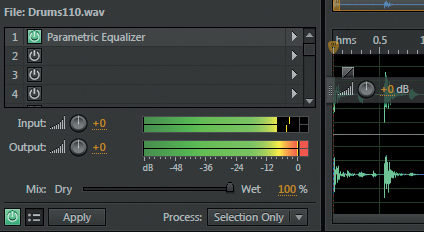
5. The Input and Output level controls default to +0dB gain, which means neither the signal coming into the Effects Rack, nor the signal leaving it, is amplified or attenuated. However, the massive EQ boost is overloading the output. Turn up the monitoring level enough so you can hear the distortion this causes.
6. It’s generally good practice to keep the Output control at +0dB and compensate for the excessive levels by trimming the Input level. Reduce the Input level until the peaks no longer trigger the red distortion indicators. This will likely require reducing the Input to -35dB or so.
Tip
You can click anywhere in the Output meter to reset the red distortion indicators. To reset the Input or Output knob to +0dB, Alt-click (Option-click) on the knob. You can also toggle the Meters/Controls view with the button to the right of the panel’s master on/off switch in the lower left.
Keep this project open for the next lesson.
Altering the effect’s wet/dry mix
An unprocessed signal is called dry, whereas one to which effects have been applied is called wet. Sometimes you want a blend of the wet and dry sounds rather than all of one or the other.
1. With the previous project still open and the levels set properly to avoid distortion, click on the Mix slider below the meters and drag left.
2. Drag the slider to the right to increase the amount of wet, filtered sound, and drag to the left to increase the amount of dry, unprocessed sound.
Tip
Using the Mix slider to blend in more dry sound provides an easy way to make an effect more subtle.
Applying effects
Inserting an effect doesn’t change the file but instead plays the original file back through the effect. This is called a nondestructive process using a real-time effect, because the original file remains unaltered.
However, you may want to apply the effect to the entire file, or only a selection, so that saving the file saves the processed version.
1. If Audition is open, close it without saving so you can start fresh. Open the program, choose File > Open, navigate to the Lesson04 folder, and open the file Drums110.wav.
2. In any effect’s insert, click the right arrow and choose Reverb > Studio Reverb.
3. When the Studio Reverb window appears, choose the preset Drum Plate (Small) from the presets drop-down menu.
4. The Process drop-down menu, located in the toolbar at the bottom of the Effects Rack panel, allows you to apply the effect to the entire file or just a selection. For this lesson, choose Entire File.
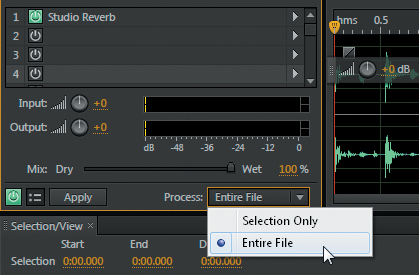
5. Click the Apply button. This not only applies the effect to the file to process it, but deletes the effect from the Effects Rack so the file isn’t “double processed” from the effect being embedded in the file and from a processor remaining in the rack.
Note
You can insert additional effects into the Effects Rack to change the sound further, and then apply those effects. The file will then reflect the changes caused by all the effects you’ve applied. Also note that any changes are still not permanent until you save (using either Save or Save As) the file. At that point, the effects will be embedded permanently in the file.
6. Close the project without saving by choosing File > Close All.
Let’s move on to lessons that show how individual effects change the sound.
Amplitude and Compression effects
Amplitude and Compression effects change levels or alter dynamics. You’ll load each effect individually to hear how each one changes the sound.
Amplify
Amplify can make a file louder or softer. When increasing amplitude to make a file louder, choose a low enough amount of amplification so that the file remains undistorted.
1. If Audition is open, close it without saving so you can start fresh. Open the program, choose File > Open, navigate to the Lesson04 folder, and open the file Drums+Bass+Arp110.wav.
2. Click an Effects Rack insert’s right arrow button, and then choose Amplitude and Compression > Amplify.
3. Enable looping on the Transport, and then start playback.
Amplify has only one parameter, Gain, which varies from -96dB (maximum attenuation) to +48dB (maximum amplification). With Link Sliders selected, adjusting gain for one channel changes gain equally in the other channel. Deselecting Link Sliders allows for adjusting each channel individually.
4. With Link Sliders selected, click the Gain slider and drag left (attenuation) or right (amplification). You can also drag up/down or left/right in the numerical field to change gain in integer increments, or double-click on the numerical field and type in a specific number.
5. Using the numerical field, increase the gain to +2dB, and observe the Output meters. They do not go into the red so it is safe to increase the gain by this amount. Now increase the gain to +3dB. The Output meter goes into the red, which shows that the gain is too high and is overloading the output. Also, try decreasing the level and listen to the results.
6. Stop playback, click on the effect’s insert with Amplify applied, and press the Delete key. Keep Audition open.
Channel Mixer
The Channel Mixer alters the amount of left and right channel signal present in the left and right channels. Consider two possible applications: converting stereo to mono and reversing the left and right channels.
1. Click an Effects Rack insert’s right arrow button, and then choose Amplitude and Compression > Channel Mixer.
2. With looping enabled on the Transport, begin playback.
3. Click the Channel Mixer’s L (left) tab. It’s currently set so that the left channel consists entirely of signal from the left channel. You’ll convert this stereo signal into a monaural signal by having equal amounts of left and right channel signals in the left and right channels.
4. With the L tab still selected, move both the L and R sliders to 50.
5. Bypass the Channel Mixer using either the Effects Rack’s power on/off button or the one in the Channel Mixer panel’s lower left. When bypassed, the stereo image is wider.
6. Enable the Channel Mixer by making sure the power button is on, and let’s complete converting the signal to mono.
7. Click the R tab and adjust the L and R sliders to 50. Now the signal is monaural. Bypass and enable the Channel Mixer to verify.
Note
Converting stereo to mono is a common enough operation that the Channel Mixer preset named All Channels 50% performs this conversion.
8. The Channel Mixer also makes it easy to swap channels. Click the L tab and set the L slider to 0 and the R slider to 100. Now the left channel consists entirely of signal from the right channel.
9. Click the R tab. Set the L slider to 100 and the R slider to 0. Now the right channel consists entirely of signal from the left channel.
10. Bypass and enable the Channel Mixer; doing so reverses the two channels. When bypassed, the hi-hat is in the left channel. When enabled, it’s in the right channel.
11. Stop playback, click the effect’s insert that contains the Channel Mixer, and then press the Delete key. Keep Audition open.
DeEsser
Audition’s DeEsser reduces vocal sibilants (“ess” sounds). De-essing is a three-step process: Identify the frequencies where sibilants exist, define that range, and then set a threshold, which if exceeded by a sibilant, automatically reduces the gain within the specified range. This makes the sibilant less prominent.
1. If Audition is open, close it without saving so you can start fresh. Choose File > Open, navigate to the Lesson04 folder, and open the file DeEsser.wav.
2. Click an Effects Rack insert’s right arrow button, and then choose Amplitude and Compression > DeEsser.
3. Enable looping on the Transport, and then start playback.
4. As the file plays, you’ll see a display of the frequency spectrum. Sibilants are high frequencies. Look carefully at the spectrum and confirm that you see peaks in the range around 10000Hz.
5. To make it easier to find the sibilants, set the Threshold to -40dB and Bandwidth to 7500Hz.
6. Vary the Center Frequency. When set to maximum (12000Hz), you can still hear quite a bit of sibilance because this is higher than the sibilants’ frequency. Similarly, when set to minimum (500Hz), the sibilants are above this range and are still audible. You’ll find a “sweet spot” between 9000 and 10000Hz that reduces sibilants.
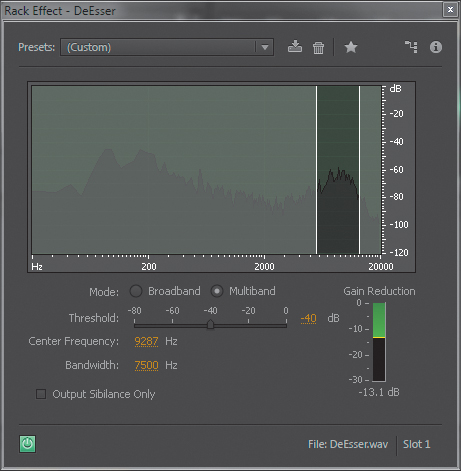
7. To fine-tune this further, select Output Sibilance Only. Now you’ll hear only the sibilants. Adjust the Center Frequency to hear the greatest amount of sibilants and the least amount of the voice, which will be around 10400Hz. The Gain Reduction meter shows the sibilant range’s attenuation.
8. Deselect Output Sibilance Only, and bypass/enable the DeEsser to hear the difference.
9. Stop playback, click the effect’s insert that includes the DeEsser, and press the Delete key.
10. Choose File > Close and don’t save the file. Keep Audition open.
Dynamics processing
With a standard amplifier, the relationship between the input and output is linear. In other words, if there’s a gain of 1, the output signal will be the same as the input signal. If there’s a gain of 2, the output signal will have twice the level of the input signal, whatever the input signal level may be.
A Dynamics Processor changes the relationship of the output to the input. This change is called compression when a large input signal increase produces only a small output signal increase and expansion when a small input signal increase produces a large output signal increase. Both can be present at the same time by expanding signals within one range of levels and compressing signals in a different range of levels. The Dynamics Processor’s graph shows the input signal on the horizontal axis and the output on the vertical axis.
Compression can make a sound subjectively louder and is the tool that makes TV commercials SO MUCH LOUDER THAN EVERYTHING ELSE. Expansion is less common; one application is to expand objectionable low-level signals (like hiss) to reduce their levels further. There are also many uses for both as special effects.
In the following graph, as the input signal changes from -100dB to -40dB, the output changes from -100dB to only -95dB. As a result, the Dynamics Processor has compressed 60dB of input dynamic range into 5dB of change at the output. But from -40dB to 0dB, the output changes from -95dB to 0dB. Therefore, the Dynamics Processor has expanded 40dB of input dynamic range into 95dB of output dynamic range.
In the graph these ranges are given a segment number, and the area below the graph provides information about each segment:
• The segment number
• The relationship between output and input expressed as a ratio
• Whether the segment is an Expander or Compressor
• The Threshold (range of levels) where the expansion or compression takes effect
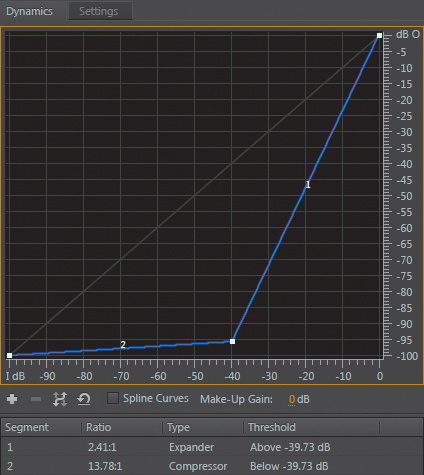
The easiest way to become familiar with dynamics processing is to call up presets, listen to how they affect the sound, and correlate what you hear to what you see on the graph.
1. Choose File > Open, navigate to the Lesson04 folder, and open the file Drums+Bass+Arp110.wav.
2. Click an Effects Rack insert’s right arrow button, and then choose Amplitude and Compression > Dynamics Processing.
3. Enable looping on the Transport, and then start playback.
4. Select various presets. Note that you will need to turn down the Effects Rack’s Output level with some of the more “aggressive” presets to avoid distortion.
5. Create your own dynamics processing. Choose the (Default) preset, which provides neither compression nor expansion.
6. Click on the little white square in the upper right and drag it down slowly to around -10dB. You’ll hear how this brings down peaks and makes the sound less dynamic.
7. Create a less abrupt change. Click in the middle of segment 1 (e.g., where the segment crosses -15dB) to create another square. Drag it up a little bit to around -12dB.
8. Now you’ll use expansion to reduce low-level sounds. Click on the line at -30dB and -40dB to create two more squares. Click on the one at -40dB, and drag it down all the way to -100dB. This effect makes the drums sound more percussive.
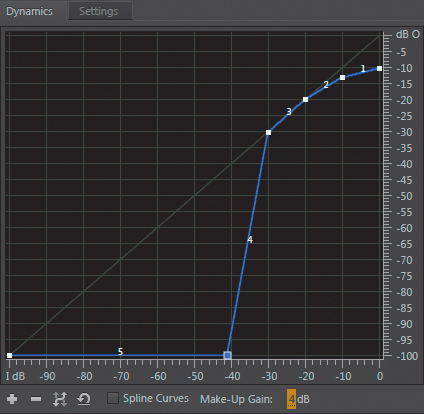
Note
Audition’s Dynamics Processor is extremely sophisticated. Although you’ve just experienced the basic concepts in the dynamics processing exercise, the Settings page allows for further customization and effects. Basic compression and expansion can solve most audio problems that need dynamics control, but please refer to the Audition documentation for detailed information on other Dynamics Processor parameters.
9. Look at the Effects Rack’s Output meter. Bypass the dynamics processing, and you’ll note that the signal is actually a little louder because compression has reduced the peaks. To compensate for this, click in the Dynamics Processor’s Make-Up Gain parameter located just below the curve’s horizontal axis. Increase the gain by +4dB.
10. Bypass and enable the Dynamics Processor. By adding Make-Up gain, the processed signal is now a little bit louder.
11. Stop playback, click the effect’s insert with the Dynamics Processor, and press the Delete key. Don’t close the file, and leave Audition open.
Hard limiter
Like an engine’s governor that limits the maximum number of RPMs, a limiter restricts an audio signal’s maximum output level. For example, if you don’t want an audio file to exceed a level of -10dB, yet there are some peaks that reach -2dB, set the limiter’s Maximum Amplitude for -10dB and it will “absorb” the peaks so they don’t exceed -10dB. This is different from simple attenuation (which lowers the levels of all signals), because in this example of limiting, levels below -10dB remain untouched. Levels above -10dB are compressed with an essentially infinite ratio, so any input level increase produces no output level increase above -10dB.
This limiter also has an Input Boost parameter, which can make a signal subjectively louder. Here’s why: If you set the Maximum Amplitude to 0, you can increase the level of an input signal that already reaches the maximum headroom because the limiter will prevent it from distorting by “clamping” its output to 0. Let’s listen to how this affects a mix.
1. With the Drums+Bass+Arp110.wav still loaded, click an Effects Rack insert’s right arrow button, and choose Amplitude and Compression > Hard Limiter.
2. Enable looping on the Transport, and then start playback.
3. Look at the Maximum Amplitude numeric field to confirm that the default value is -0.1. This level ensures that the signal won’t hit zero, so the output won’t trigger the red zone in the Effects Rack panel’s Output level meters.
4. Raise the Input Boost amount above 0 while observing the Output level meters. Note that even if you add lots of boost, like 10dB, the output still doesn’t go above -0.1, and the Output meters never go into the red.
5. The Release Time sets how long it takes for the limiter to stop limiting after a signal no longer exceeds the maximum amplitude. In most cases the default is fine. With a fair amount of input boost, shorter Release settings—even though they limit the signal more accurately—produce a “choppy” effect. With the Input Boost set to around +16dB, move the Release Time slider all the way to the right to hear this “choppiness.” When using the Release Time slider, the rule of thumb is to set it for the most natural sound.
Note
There’s a point of diminishing returns with hard limiting. Past a certain amount of input boost, the sound will become unnatural. The level at which this will occur varies depending on the input signal source. With voice, you can usually get away with more boost than with a full mix of something like a band.
6. The Look-Ahead Time allows the limiter to react to fast transients. With no look-ahead time, the limiter has to react instantly to a transient, which is not possible: It has to know a transient exists before it can decide what to do with it. Look-Ahead alerts the limiter when a transient is coming, so the reaction can be instantaneous. Longer settings cause a slight delay through the effect, although in most cases this doesn’t matter. The default setting is fine, but experiment with increasing the Look-Ahead Time slider if the transients sound “mushy.”
Single-Band Compressor
The Single-Band Compressor is a “classic” compressor for dynamic range compression and is an excellent choice for learning about how compression works.
As explained in the “Dynamics processing” section, compression changes the relationship of the output signal to the input signal. The two most important parameters are Threshold (the level above which compression starts to occur) and Ratio, which sets the amount of change in the output signal for a given input signal change. For example, with a 4:1 ratio, a 4dB increase in input level produces a 1dB increase at the output. With an 8:1 ratio, an 8dB increase in input level produces a 1dB increase at the output. In this lesson you’ll hear how compression affects the sound.
1. If the Drums+Bass+Arp110.wav is not open, close any currently open files and open it. Also, delete any currently loaded effects.
2. Click the Effects Rack insert’s right arrow button, and choose Amplitude and Compression > Single-Band Compressor.
3. Enable looping on the Transport, and then start playback.
4. Assuming the Default preset is loaded, move the Threshold slider over its full range. You won’t hear any difference because the Ratio defaults to 1:1, so there’s a linear relationship between the output and input.
5. With Threshold at 0, move the Ratio slider over its full range. Again you won’t hear any difference, because all audio will lie below the Threshold—so there’s nothing above the Threshold that can be affected by the Ratio slider. This shows how the Threshold and Ratio controls interrelate, and explains why you usually need to go back and forth between these two controls to dial in the right amount of compression.
6. Set the Threshold slider to -20dB and the Ratio slider to 1. Slowly increase the Ratio slider by moving it to the right. The farther you move it to the right, the more compressed the sound. Leave the Ratio slider at 10 (i.e., 10:1).
7. Experiment with the Threshold slider. The lower the Threshold, the more compressed the sound; below about -20dB, with a Ratio of 10:1, the sound becomes so compressed as to be unusable. Leave the Threshold slider at -10dB for now.
8. Look at the Effects Rack panel’s Output meter. When you bypass the Single-Band Compressor, note that the meters are more animated and have more pronounced peaks. Enable the Single-Band Compressor; the signal’s peaks are less dynamic and more uniform.
9. Note the maximum peak level in bypassed mode. Then with the Single-Band Compressor enabled, adjust its Output Gain control to around 2.5-3.0dB, so its peaks match the same level as when bypassed. Now when you compare the bypassed and enabled states, you’ll hear that despite having the same peak levels, the compressed version sounds louder. The reason is that reducing peaks allows for increasing the overall output gain without exceeding the available headroom or causing distortion.
10. It’s possible to make this difference even more pronounced. Attack sets a delay before the compression occurs after a signal exceeds the threshold. Allowing a slight Attack time, like the default setting of 10ms, lets through percussive transients up to 10ms in duration before the compression kicks in. This retains some of a signal’s natural percussiveness. Now set the Attack time to 0.
11. Again, observe the Output level meters. With 0 Attack time, the peaks have been reduced even further, which means the Single-Band Compressor Output Gain can go even higher; set it to 6dB, and when you enable/bypass the Single-Band Compressor, the peak levels are the same—yet the compressed version sounds a lot “bigger.”
12. Release determines how long it takes for the compression to stop compressing once the signal falls below the threshold. There are no rules about Release time; basically, set it subjectively for the smoothest, most natural sound, which will usually lie between 200 and 1000ms.
13. Keep Audition open and loaded with the same file.
Tube-Modeled Compressor
The Tube-Modeled Compressor has the same control complement as the Single-Band Compressor but offers a slightly different, somewhat less “crisp” sonic character. You can use the same basic steps as in the previous lesson to explore the Tube-Modeled Compressor. The one obvious difference is that the Tube-Modeled Compressor has two meters: the one on the left shows the input signal level, and the one on the right shows how much the gain is being reduced to provide the specified amount of compression.
Multiband Compressor
The Multiband Compressor is another variation on the “classic” Single-Band Compressor. It divides the frequency spectrum into four bands, each with its own compressor. Therefore, it’s possible to compress some frequencies more than others, such as adding lots of compression to bass but only a moderate amount of compression in the upper midrange.
Dividing the signal into four bands also embodies elements of equalization (described later), because you can alter a signal’s frequency response.
If you think adjusting a Single-Band Compressor is complex, a Multiband Compressor with four bands isn’t just four times as complex—all these stages also interact with each other. Rather than describe how to create a multiband compression setting from scratch, you’ll load various presets and analyze why they sound the way they do. Note that each band has an S (Solo) button, so you can hear what that band alone is doing.
1. If the Drums+Bass+Arp110.wav is not open, close any currently open files and open it. Also, delete any currently loaded effects.
2. Click an Effects Rack insert’s right arrow button, and choose Amplitude and Compression > Multiband Compressor.
3. Enable looping on the Transport, and then start playback.
4. The Default preset doesn’t apply any multiband compression, so listen to that first as a point of reference.
5. Load the Broadcast preset, which gives a major boost to the sound. Note that the highest and lowest bands have more gain and a higher compression ratio, which give a little more “sizzle” and “depth,” respectively.
6. Load the Enhance Highs preset. This shows how multiband compression can add an element of equalization; the output gain for the two upper bands is considerably higher than the two lower bands.
7. Load the Enhance Lows preset. This is the mirror image of the Enhance Highs preset. The two lower bands’ output gain is higher than the two higher bands.
8. Load the Hiss Reduction preset, and notice that there’s a lot less highs. The reason is that the highest band has an extremely low threshold of -50dB, so even low-level, high-frequency sounds are compressed.
Speech Volume Leveler
The Speech Volume Leveler incorporates three processors—leveling, compression, and gating—to even out level variations with narration, as well as reduce background noise with some signals.
1. If Audition is open, close it without saving. Open the program, choose File > Open, navigate to the Lesson04 folder, and open the file NarrationNeedsHelp.wav.
2. Click an Effects Rack insert’s right arrow button, and choose Amplitude and Compression > Speech Volume Leveler.
3. Bypass the effect, and listen to the file all the way through. Note the two quiet parts where the narration says, “Most importantly, you need to maintain good backups of your data” and “Recovering that data will be a long and expensive process.” The rest is at a reasonable volume. You’ll use the Speech Volume Leveler to match the levels.
4. Select the audio that says, “Most importantly, you need to maintain good backups of your data.” Move the Speech Volume Leveler sliders for Target Volume Level and Leveling Amount all the way to the left, and then enable the effect.
5. Click the Transport Loop button, and then click Play.
6. Move the Leveling Amount slider to the right while observing the Input and Output meters in the Effects Rack panel. As you move the slider to the right, the output will become louder than the input. Choose a value of about 60 for now. The output will peak at around -6dB.
7. Select the audio that says, “If all your precious music is stored on a hard drive,” loop it and play it. Adjust the Target Volume Level until the peaks match the peaks you saw in step 6. The slider should be around -19dB.
8. Double-click on the waveform to select it all, and then listen. There should be fewer volume variations between the soft and loud sections.
9. Click the disclosure triangle next to the Advanced options to reveal two more settings.
10. To even out levels even further, enable the compressor and move the Threshold to the left (more negative numbers) to produce a consistent, natural sound.
11. High Leveling Amount settings can bring up low-level noise, and the Noise Gate can compensate for this. To best hear how this works, with the Leveling Amount at the default setting of 100, select the audio between 2 and 6 seconds, and loop it.
12. Note that the noise becomes very prominent in the space between “data” and “if.” Select the Noise Gate, and move the Noise Offset slider all the way to the right (25dB). This doesn’t eliminate the noise but reduces it considerably. Move the Leveling Amount back to 60, and the noise goes away.
13. Click the power button to bypass and enable the Speech Volume Leveler a few times so you can hear how the effect alters the sound. Observe the meters, and see if further tweaking can help create a more consistent output. For this particular file, a setting with Compressor and Noise Gate off, Target Volume Level at -18dB, and a Leveling Amount of 50% seems about optimum.
14. To see how this process affects the file’s waveform, in the lower part of the Effects Rack panel, choose Process: Entire File from the drop-down menu, and then click Apply. You’ll see that the waveform is much more consistent. In the illustration the top waveform is the original file, whereas the lower one has been processed by the Speech Volume Leveler. To compare the two, choose Edit > Undo Apply Effects Rack, and then choose Edit > Redo Apply Effects Rack.
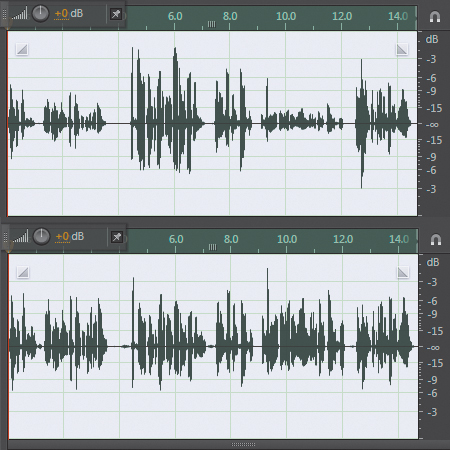
Note
The Boost Low Signal option raises levels for short, low-volume passages by reducing the attack and decay time of the effect so it changes levels more rapidly. You’ll usually want this option off, but try enabling it to determine if there’s an improvement.
Delay and echo effects
Adobe Audition has three echo effects with different capabilities. All delay effects store audio in memory and then play it back later. The time that elapses between storing it and playing it back is the delay time.
Delay
Delay simply repeats the audio, with the repeat’s start time specified by the delay amount.
1. If Audition is open, choose File > Close All. Don’t save any changes. Choose File > Open, navigate to the Lesson04 folder, and open the file Arpeggio110.wav.
2. Click an Effects Rack insert’s right arrow button, and then choose Delay and Echo > Delay.
Note
Stereo audio has separate delays for the left and right channels, whereas mono audio has only a single delay.
3. The Mix slider sets the proportion of dry and delayed audio. Set the Right Channel to full Dry and the Left channel to full Wet. This makes it easy to hear the difference between the delayed signal in the left channel and the dry signal in the right channel.
4. Set the left channel Delay Time slider full right (500ms). You’ll now hear the left channel arpeggio delayed by half a second compared to the right channel.
Note
You can specify delay time (lower-left drop-down menu) in milliseconds, beats, or samples. Beats is most useful in Multitrack view, where the project has a particular tempo. Samples is useful for tuning out short timing differences, because you can specify delays down to 1 sample (at a 44,100Hz sample rate, that’s a delay of 22.7 microseconds or 0.00002267 seconds).
5. Set the left channel Delay Time slider full left (-500ms). You’ll now hear the arpeggio start half a second earlier in the left channel than in the right channel.
6. Set both Mix sliders to 50%, and experiment with different delay times. You’ll hear a mix of delayed and dry sounds in each channel. Leave Adobe Audition open for the next lesson.
Analog Delay
Before digital technology, delay used tape or analog delay chip technology. These produced a more gritty, colored sound compared to digital delay. Audition’s Analog Delay provides a single delay for stereo or mono signals and offers three different delay modes: Tape (slight distortion), Tape/Tube (crisper version of tape), and Analog (more muffled). Analog Delay simply repeats the audio with the start time of the repeat specified by the delay amount. Unlike the Delay effect, there are separate controls for Dry and Wet levels instead of a single Mix control. The Delay slider provides the same function as the Delay effect except that the maximum delay time is 8 seconds.
1. If Audition is open, choose File > Close All. Don’t save any changes. Choose File > Open, navigate to the Lesson04 folder, and open the file Drums110.wav.
2. Click an Effects Rack insert’s right arrow button, and then choose Delay and Echo > Analog Delay.
Tip
With rhythmic material, correlating delay to the rhythm creates a more “musical” effect. Use the formula 60,000/tempo in bpm (beats per minute) to determine the echo for a quarter note. For example, the drum loop tempo is 110 bpm, so the echo time for a quarter note is 60,000/110 = 545.45ms. An eighth note is half that or 272.72ms, a 16th note is 136.36ms, and so on. The Lesson04 folder includes a file called Period vs. Tempo.xls. Enter a tempo in this spreadsheet to see the number of milliseconds and samples that correspond to particular rhythmic values.
3. Set Dry Out to 60%, Wet Out to 40%, and Delay to 545ms. Feedback determines the number of repeats as they fade out. No Feedback (a setting of 0) produces a single echo, values moving toward 100 produce more echoes, and values above 100 produce “runaway echoes” (watch your monitor volume!).
4. With feedback at 50, set the Trash control to 100. Change the different modes (Tape, Tape/Tube, Analog) to hear how each affects the sound. Vary the feedback, being careful to avoid excessive, runaway feedback.
5. Spread at 0% narrows the echoes to mono and at 200% produces a wide stereo effect. Play with the various controls, and you’ll hear anything from dance mix drum effects to 1950s sci-fi movie sounds. Keep Audition open for the next lesson.
Echo
Audition’s Echo effect allows for tailoring the echoes’ frequency response by inserting a filter in the delay’s feedback loop, where the output feeds back to the input to create additional echoes. As a result, each successive echo processes each echo’s timbre to a greater degree. For example, if the response is set to be brighter than normal, each echo will be brighter than the previous one.
1. With the Drum110.wav file open, assuming the Analog Delay effect is still inserted, click its insert’s right arrow, and then choose Delay and Echo > Echo.
2. Compared to the previous delay effects, Echo has yet another way of setting the echo mix; each channel has an Echo Level control that dials in the echo amount. The Dry signal is fixed. When using the echo effect, enter the following values for the left channel: Delay Time 545ms, Feedback 90%, and Echo Level 70%. Enter the following values for the right channel: Delay Time 1090ms, Feedback 70%, and Echo Level 70%.
Tip
To set both channels to the same Delay Time, enable Lock Left and Right. Adjusting either channel will adjust the other to the same value.
3. Bring all Successive Echo Equalization controls all the way down (-15dB). That makes it easier to hear the difference moving a single slider has on the sound.
4. Raise the 1.4kHz control to 0 (values above 0 produce runaway echo) and note how the sound is more “midrangey.”
5. Bring down the 1.4kHz slider and raise the 7.4kHz slider to 0. Now the echoes are brighter.
6. Return the 7.4kHz slider to -15dB, and raise the 172Hz slider to 0. The echoes are now bassy.
7. You can vary more than one slider at a time to create a more complex equalization curve, as well as enable Echo Bounce to have each channel’s echo bounce between the left and right channels.
Filter and EQ effects
Equalization is an extremely important effect for adjusting tonality. For example, you can “brighten” muffled narration by boosting the treble or make tinny, thin-sounding voices sound fuller by increasing the low frequencies. Equalization can also help differentiate among different instruments; for example, bass guitar and a drum kit’s kick drum both occupy the low frequencies and can interact in a way that makes each one less distinct. To solve this problem, some engineers might emphasize the bass’s highs to bring out pick and string noise, whereas others boost highs on the kick to bring out the “thwack” of the beater.
Adobe Audition has four different equalizer effects, each used for different purposes, that can adjust tonality and solve frequency-response related problems: Parametric Equalizer, Graphic Equalizer, FFT (Fast Fourier Transform) Filter, and Notch Filter.
Parametric Equalizer
The Parametric Equalizer offers nine stages of equalization. Five stages have a parametric response, which can boost (make more prominent) or cut (make less prominent) specific ranges (“bands”) of the frequency spectrum. Each parametric equalization stage has three parameters.
Caution: In the following lesson, keep monitor levels down as you make adjustments. The Parametric Equalizer is capable of high amounts of gain at the selected frequencies.
1. If Audition is open, close it without saving to start fresh. Open the program, choose File > Open, navigate to the Lesson04 folder, and open the file Drums+Bass+Arp110.wav.
2. In any Effects Rack insert, click the right arrow, and choose Filter and EQ > Parametric Equalizer. Start playback.
3. Note the five numbered boxes. Each represents a controllable parametric stage. Click one of them (e.g., 3) and drag up to boost response, or drag down to reduce response. Drag left to affect lower frequencies or right to affect higher frequencies. Listen to how this changes the sound.
4. In the area below the graph, each parametric stage shows the Frequency, Gain, and Q/Width parameters. Click on the Q/Width parameter and drag up to narrow the range affected by the boost or cut, or drag down to widen the range. You can also click on the stage’s number to toggle that stage on or off.
5. Load the Default preset to restore the EQ to having no effect. The L and H squares control a low shelf and high shelf response, respectively. This starts boosting or cutting at the selected frequency, but the boost or cut extends outward toward the extremes of the audio spectrum. Past a certain frequency, the response hits a “shelf” equal to the maximum amount of cut.
6. Click on the H box and drag it up slightly. Note how this increases the treble. Now drag it to the left, and you’ll hear that the boost now affects a wider range of high frequencies. Similarly, click on the L box to hear how this affects the low frequencies. In the Parameter section for the Low and High shelf sections, you can click the Q/Width button to change the steepness of the shelf’s slope.
7. Reload the Default preset so the EQ has no effect. There are two additional stages, Highpass and Lowpass, which you enable by clicking on the HP and LP buttons, respectively. Click those buttons now.
8. A Highpass response progressively reduces response below a certain frequency (called the cutoff frequency); the lower the frequency is below the cutoff, the greater the reduction. A Highpass filter is helpful for removing subsonic (very low-frequency) energy. Click on the HP box and drag it to the right to hear how it affects low frequencies.
9. You can also change the filter slope’s steepness, in other words, the rate of attenuation compared to frequency. In the HP panel that displays its parameters, click the Gain drop-down menu and choose 6dB/octave. Note how this creates a gradual curve. Then select 48dB/octave to produce a steep curve.
10. Similarly, listen to how the Lowpass filter affects the sound by clicking the LP (Lowpass) button, dragging the LP box left or right, and choosing different curves as accessed from the Gain menu. Keep this project open for the next lesson.
All of these responses are available simultaneously. The screen shot shows a steep Highpass slope, a slight parametric boost with stage 2, a narrow parametric cut with stage 3, and a High shelf boost.
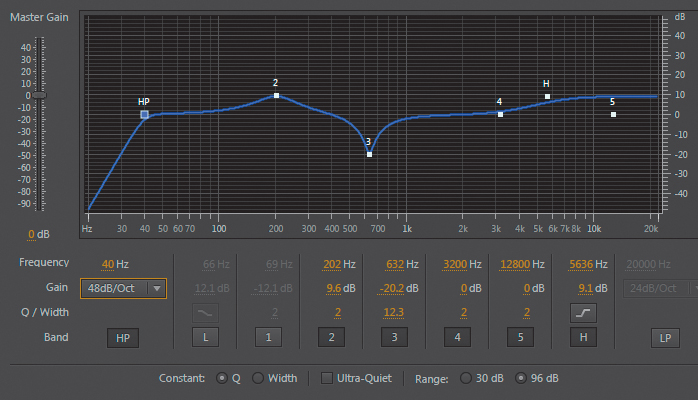
Note
The strip along the bottom of the screen has three additional options. Constant Q, where Q is a ratio compared to frequency, is most common, whereas Constant Width means the Q is the same regardless of frequency. The Ultra-Quiet option reduces noise and artifacts but requires much more processing power and can usually be left off. Range sets the maximum amount of boost or cut to 30dB or 96dB. The more common option is 30dB.
Graphic Equalizer (10 Bands)
A Graphic Equalizer can boost or cut with a fixed bandwidth at various fixed frequencies. It gets its name because moving the sliders creates a “graph” of the filter’s frequency response.
Caution: In the following lesson, keep monitor levels down as you make adjustments. The Graphic Equalizer can produce high amounts of gain at specific frequencies.
1. Assuming Audition is still open and the file Drum+Bass+Arp110.wav is still loaded, click the right arrow of the insert that had the Parametric Equalizer loaded, and choose Filter and EQ > Graphic Equalizer (10 Bands).
2. Start playback. Move the various sliders up and down to hear how each affects the timbre through varying the level within their respective frequency bands. In musical terms, each slider is an octave apart. Keep Audition open in preparation for the next lesson.
Note
The strip along the bottom of the Graphic Equalizer screen has three additional parameters. Range sets the maximum available amount of boost or cut up to 120dB (which is a lot!). It’s easier to make fine adjustments with narrower ranges, like 6–12dB. Accuracy affects low-frequency processing. If you’re doing significant amounts of low-frequency boost or cut, raise Accuracy if it improves the sound. Otherwise, leave it at the default of 1000 points to reduce CPU loading. Master gain compensates for Output level changes caused by using the EQ. Turn it down if you added lots of boosting; turn it up if you used lots of cutting.
Graphic Equalizer (20 Bands)
The Graphic Equalizer (20 Bands) works identically to the Graphic Equalizer (10 Bands) except the bands are half an octave apart, which provides greater resolution. To hear how it works, follow the same basic procedure as the lesson for the 10 Bands version.
Graphic Equalizer (30 Bands)
The Graphic Equalizer (30 Bands) works identically to the Graphic Equalizer (20 Bands) except the bands are a third of an octave apart, which provides greater resolution. To hear how it works, follow the same basic procedure as the lesson for the 10 Bands version.
FFT Filter
The FFT Filter is an extremely flexible filter that lets you “draw” the frequency response. The default settings are a practical point of departure. FFT is a highly efficient algorithm commonly used for frequency analysis.
1. Assuming Audition is still open and the file Drum+Bass+Arp110.wav is still loaded, click the right arrow of the insert that had a Graphic Equalizer loaded, and choose Filter and EQ > FFT Filter.
2. Start playback. Click on the graph to create a point; the blue line that indicates frequency response will move up or down as needed to “snap” to that point. You can then drag this point up, down, or sideways. You are not limited to the number of points you can add, which allows you to make very complex—and even truly bizarre—EQ curves and shapes.
3. For a smoother curve, enable Spline Curves. The screen shot on the left shows Spline Curves deselected and the original placement of points, whereas the screen shot on the right shows Spline Curves selected.

Note
As for other FFT Filter parameters, for Scale choose Logarithmic when working primarily with low frequencies because this produces the best resolution for drawing in nodes. Linear has the same advantage at high frequencies. For the Advanced options, for the best accuracy with steep, precise filters, choose higher values like 8192 to 32678. Lower values produce fewer transients with percussive sounds. For Window, Hamming and Blackman are the best overall choices. The choices listed first narrow the shape of the response curve with subsequent choices progressively widening the shape.
Notch Filter
The Notch Filter is optimized to remove very specific frequencies in an audio file, like hum.
1. If Audition is open, close it without saving to start fresh. Open the program, choose File > Open, navigate to the Lesson04 folder, and open the file ReduceHum.wav.
2. Click the right arrow of an effect’s insert, and choose Filter and EQ > Notch Filter.
3. Bypass the Notch Filter, and then start playback. Note the huge amount of hum in the file.
4. Select the Notch Filter. The filter’s default setting is a good start (Europeans should select the 50Hz and Harmonics Removal preset instead of the 60Hz-based default), but note that there’s some ringing and an unnatural quality. You’ll now tweak the settings to reduce hum while retaining a natural sound.
5. There are six notches starting at 60Hz whose frequencies are set to harmonics of 60Hz. Turn off all notches that don’t improve the sound by clicking a notch’s enable button. Turn off notches 3, 4, 5, and 6. Note that this doesn’t increase the amount of hum. Turn off notches 1 and 2. These contribute hum, so reenable them and let’s work on optimizing these.
6. Reduce the gain for notches 1 and 2 to around -45dB.
7. For the most natural sound, you want to use the least amount of reduction consistent with reducing hum. Experiment with the Gain parameters for notches 1 and 2. You’ll probably be able to get by with about -36dB of cut.
8. Bypass the Notch Filter, and note how the hum increases.
Modulation effects
Unlike some of the previous effects we’ve discussed, modulation effects aren’t designed to solve problems as much as add “spice” to sounds in the form of special effects. These tend to produce very specific sounds, and the presets included with Adobe Audition are a good place to start. Therefore, with most of these effects, you’ll call up presets to hear how they affect the sound. But there will also be some analysis of which parameters are most important for editing.
Chorus
Chorus can turn a single sound into what seems like an ensemble. This effect uses short delays to create additional “voices” from the original signal. These delays are modulated so that the delay varies slightly over time, which produces a more “animated” sound.
The Chorus effect is optimized for stereo signals, so convert mono signals to stereo for best results. To do this, choose Edit > Convert Sample Type, and from the Channels drop-down menu, choose Stereo. Then click OK.
1. If Audition is open, close it without saving to start fresh. Open the program, choose File > Open, navigate to the Lesson04 folder, and open the file FemaleChoir.wav. Play the file to hear what it sounds like.
2. Click the right arrow of an effect’s insert, and choose Modulation > Chorus.
3. Note how with Chorus enabled the Default preset creates a fuller and bigger sound. Select Highest Quality; most modern computers can provide the additional processing power this option needs. If the audio crackles or breaks up, deselect this option.
4. Increase Modulation Depth to 8dB or so. Notice how the sound becomes more animated. To make this more obvious, increase the Modulation Rate to 2.5Hz. Modulation Depth and Rate interact; with a higher Rate, you’ll usually want a lower Depth. Return Modulation Depth to 0.
5. To increase the “number of people” in the chorus, click the Voices drop-down menu and choose 16 voices. Because this adds a lot more audio, you may need to bring down the Output control in the Effects Rack panel to avoid distortion.
6. Increasing the Delay Time can also make a bigger sound, but too much Delay Time may produce an “out of tune” effect. Set it to around 40ms for now.
7. Spread increases the stereo image width. Set it to around 152ms. Bypass/enable the Chorus to hear the effect of these edits.
8. With Chorus enabled, note the Dry and Wet Output level controls. For a more subtle effect, set a higher Dry value and lower Wet value, or turn up only the Wet sound for the most “diffused” character.
9. Be careful with Feedback, because even slight amounts can add uncontrolled feedback. Values up to about 10 can produce a more “swirling” sound for the Chorus.
10. The remaining controls apply to stereo imaging. Stereo Field makes the output narrower or wider. For Average Left & Right Channel Output and Add Binaural Cues, simply select these. If you like the sound better, leave them selected. If there’s no audible difference, leave them deselected. Leave Average Left & Right Channel Output deselected if the original signal was mono.
11. To get a sense of how you can also use the Chorus effect for special effects, try working with the other presets. Note that some of the more bizarre sounds combine lots of modulation, feedback, or long delay times.
12. Leave Audition open in preparation for the lesson on the next effect.
Flanger
Like Chorus, Flanger uses short delays, but they’re even shorter to create phase cancellations that result in an animated, moving, resonant sound. This effect was popularized in the 1960s due to its “psychedelic” properties.
1. Assuming that Audition is open and the FemaleChoir.wav file is loaded, click the right arrow of the current effect’s insert, and choose Modulation > Flanger to replace the Chorus effect. Play the file to hear what it sounds like.
2. For a more pronounced effect, set the Mix to 50%. Alter the Feedback setting; more feedback produces a more resonant sound.
3. An important element of Flanging relates to modulating the delay. Stereo Phasing changes the phase relationship of the modulation; when set to 0, the modulation is the same in both channels. Increase the Phasing amount to offset the modulation in the two channels, which creates more of a stereo effect. Vary the Modulation Rate to change the modulation speed.
4. Initial Delay Time and Final Delay Time set the Flanger sweep range. The “standard” range is 0 to around 5ms; increasing the final Delay Time produces a sound that’s more like chorusing when the Flanger delay time reaches the longer delay. Experiment with these options.
5. The Mode options are used for specialized effects. Selecting Inverted changes the tone. Special Effects changes the flanging “character”: Enable it and see if you like what it does. The effect varies depending on the other parameter settings. Finally, Sinusoidal changes the modulation waveform to produce a somewhat more “rolling” modulation effect.
6. Call up other presets, particularly the vocal flange presets, to get a sense of the range of possibilities that the Flanger can offer. Many of the more radical patches use either high Modulation Rates, large amounts of Feedback, longer Initial or Final Delay Times, or a combination of these.
7. Leave Audition open in preparation for the lesson on the next effect.
Chorus/Flanger offers a choice of Chorus or Flanger; each is a simpler version of the Chorus and Flanger described previously. Width is essentially the same as varying Delay in the Chorus or Flanger, whereas Width basically determines the wet/dry mix. Speed provides the same function as Modulation Rate. The only different control is Transience, which emphasizes transients to produce a “sharper” sound.
1. Assuming that Audition is open and the FemaleChoir.wav file is loaded, click the right arrow of the current effect’s insert, and choose Modulation > Chorus/Flanger to replace the Flanger effect.
2. Load the various presets to hear the types of effects each processor provides.
3. Leave Audition open in preparation for the next lesson.
Phaser
The Phaser effect is similar to Flanging but has a different, and often more subtle, character because it uses a specific type of filtering called an allpass filter to accomplish its effect instead of delays.
1. Assuming that Audition is open and the FemaleChoir.wav file is loaded, click the right arrow of the current effect’s insert, and choose Modulation > Phaser to replace the Chorus/Flanger effect. Play the file.
2. Phasing tends to be most effective when processing the midrange. Change the Upper Freq to around 2000Hz.
3. As with Flanging, you can offset the modulation for the left and right channels. The farther you move the Phase Difference away from the center (0) position, the greater the stereo effect. Leave it at 180 for now.
4. Moving Feedback off center to more positive values increases the phaser’s sharpness, producing a “whistling” sound. More negative values produce a subtler, “hollower” sound. Leave it at 0.
5. Vary the Mod Rate slider. Note how at faster settings the effect is almost like vibrato. Return it to 0.25Hz before proceeding.
6. The remaining parameters set the degree of “drama” in the phased sound:
• More Stages produces a more profound effect.
• Intensity determines how much phase-shifting the Phaser applies (you’ll typically want this above 90 unless you prefer a more “static” sound).
• Depth sets the lower frequency limit that Modulation attains. This complements the Upper Frequency parameter, which is the highest frequency that Modulation attains.
• Mix sets the blend of wet and dry sounds. A 50% value produces the maximum phasing effect by mixing dry and wet signals in equal proportion. Moving the value toward 0 increases the proportion of dry signal to wet signal, whereas moving the value toward 100 increases the proportion of wet signal to dry signal.
Experiment with these parameters to hear how they affect the sound.
7. Load the various presets to hear the types of effects each processor provides.
Noise reduction/restoration
Noise reduction and noise restoration are such important topics that these processors are covered in detail in Lesson 5, “Audio Restoration,” which describes Adobe Audition’s many options for audio restoration. These include the ability to remove noise, delete pops and clicks, minimize the sound caused by scratches in vinyl records, reduce tape hiss, and more.
Reverb effects
Reverberation imparts an acoustic space’s characteristics (room, concert hall, garage, plate reverb) to audio. Two common reverb processes are convolution reverb and algorithmic reverb. Audition includes both.
Convolution Reverb is generally the more realistic sounding of the two. It loads an impulse, which is an audio signal (typically WAV file format) that embodies the characteristics of a particular, fixed acoustic space. The effect then performs convolution, a mathematical operation that operates on two functions (the impulse and the audio) to create a third function that combines the impulse and the audio, thus impressing the qualities of the acoustic space onto the audio. The trade-off for realism is a lack of flexibility.
Algorithmic Reverb creates an algorithm (mathematical model) of a space with variables that allow for changing the nature of that space. It’s therefore easy to create different rooms and effects with a single algorithm, whereas for convolution reverb, you would need to load different impulses for fundamentally different sounds. All Audition reverbs other than the Convolution Reverb use algorithmic reverb technology.
Each type of reverb is useful. Some engineers prefer algorithmic reverbs because it’s possible to create “idealized” reverb spaces; others prefer convolution due to its “real” feel.
Convolution Reverb
The convolution type of reverb can produce extremely realistic reverberation effects, and as described later, can also be useful for sound design. However, it is a CPU-intensive process.
1. If Audition is open, close it without saving to start fresh. Open the program, choose File > Open, navigate to the Lesson04 folder, and open the file Drums110.wav. Play the file to hear what it sounds like.
2. Click the right arrow of an effect’s insert, and choose Reverb > Convolution Reverb.
3. Load some presets to get a sense of what convolution reverb can do. When you’re done, load the Memory Space preset.
4. Load different impulses from the Impulse drop-down menu. Note how each impulse produces a different reverb character. When you’re done, load the Hall impulse so you can check out how the various parameters affect the sound.
5. Vary Mix to change the ratio of dry to wet sounds.
6. Room Size changes the size of the hall. Listen carefully to the degree of control this option provides, because you’ll be comparing the range available with algorithmic reverb.
7. Damping LF and Damping HF affect frequency response. Move the Damping LF slider to the left to simulate the effect of a room with lots of sound-absorbing material, which absorbs high frequencies more readily than low frequencies. Move the Damping HF slider to the left to remove lower frequencies, creating a “thinner” but also less “muddy” reverb character.
Tip
You can use Convolution Reverb to load most WAV files by clicking Load and navigating to a WAV file. Online sources offer free impulses that work with standard convolution reverbs, including Audition’s, which make it easy to expand your options. Also, you can load phrases, loops, sound effects, or other “nonacoustic space” files and obtain some pretty wild—and unpredictable—effects. These can be valuable for sound design and special effects.
8. Pre-Delay sets the time before a sound first occurs and when it reflects off a surface. Move the Pre-Delay slider to the right to increase the pre-delay amount, which implies a longer time for the sound to reflect, hence a bigger space.
9. Move Width farther to the right to create a wider stereo image; move the slider to the left to narrow the image. Adjust Gain to set the overall gain of the composite wet/dry sound. This will typically be at 0 unless you need to compensate for signal level variations caused by adding the reverb effect.
10. Leave Audition open for the next lesson.
Studio Reverb
We’re covering these reverbs out of sequence because the Studio Reverb is an algorithmic reverb that’s simple, effective, and works in real time so it’s easy to hear the results of changing parameters. Many of the Full Reverb and Reverb parameters cannot be adjusted during playback, because they are very CPU-intensive.
1. Assuming that Audition is open and the Drums110.wav file is loaded, click the right arrow of the current effect’s insert, and choose Reverb > Studio Reverb to replace the Convolution Reverb effect.
2. With the Default preset selected, vary the Decay slider. Note how the range is much wider than the Convolution Reverb’s Room Size parameter.
3. Algorithmic reverbs contain two main components: early reflections and a reverb “tail.” The early reflections simulate the discrete echoes caused when a sound first bounces off multiple room surfaces. The tail is the “wash” of composite echoes that have bounced around the room multiple times. Drag the Decay slider all the way to the left, and then vary the Early Reflections slider. Increasing early reflections creates an effect somewhat like a small acoustic space with hard surfaces.
Tip
Low to moderate Early Reflections settings, with Decay set to minimum, can add a little bit of ambience to otherwise “dry” sounds. This can make narration seem more “real.”
4. Set Decay to about 6000ms and Early Reflections to 50%. Adjust the Width control to set the stereo imaging, from narrow (0) to wide (100).
5. High Frequency Cut works similarly to the Convolution Reverb’s Damping LF but covers a wider range. Move the slider more to the left to reduce the high frequencies for a darker sound or more to the right for a brighter sound.
6. Low Frequency Cut resembles the Convolution Reverb’s Damping HF. Move the LF Cut slider to the right to reduce low-frequency content, which can “tighten up” the low end and reduce “muddiness,” or more to the left if you want the reverb to affect lower frequencies.
Tip
Engineers often reduce the low frequencies on reverb to prevent adding reverb to bass and drums, which can produce a “muddy” sound.
7. Damping provides the same function as the Convolution Reverb’s Damping LF parameter. The difference between damping and High Frequency Cut is that damping applies progressively more high-frequency attenuation the longer a sound decays, whereas the high frequency cut is constant. Experiment with damping.
8. Vary the Diffusion control. At 0% the echoes are more discrete. At 100% they’re blended together into a smoother sound. In general, high-diffusion settings are common with percussive sounds; low-diffusion settings are used with sustaining sounds (e.g., voice, strings, organ, etc.).
9. The Output level section varies the amount of dry and wet audio. Experiment with these options.
10. Leave Audition open for the next lesson.
Reverb
When you call up the Reverb effect, you’ll likely see a warning alerting you that this is a CPU-intensive effect and advising you to apply the effect before playback. Also, you cannot adjust the reverb characteristics in real time—only when playback is stopped. You can edit the dry and wet levels at any time.
1. Assuming that Audition is open and the Drums110.wav file is loaded, click the right arrow of the current effect’s insert, and choose Reverb > Reverb to replace the Studio Reverb effect.
2. Call up various presets and vary the dry and wet sliders. Because you’re processing a drum sound, Big Drum Room and Thickener can be very useful; they’re designed specifically to enhance drums.
3. The remaining parameters (Decay Time, Pre-Delay Time, and Diffusion) perform the same function as the like-named parameters in the Studio Reverb and Convolution Reverb. You’ve already heard the sonic results caused by changing these sliders in the previous lessons, but if you want to hear how they alter the sound in this particular reverb, vary these sliders and listen to how they change the sound. The Perception slider is similar to high-frequency damping; at 0 the sound is “duller” and softer, whereas a setting of 200 simulates more irregularities in the listening environment, so the sound is brighter and “harder.” Try different settings of the Perception slider and listen to the results; the difference is relatively subtle. Leave Audition open.
Full Reverb
Full Reverb is a convolution-based reverb and is the most sophisticated of the various reverbs but also the most impractical to use because of the heavy CPU loading. No parameters other than the level controls for dry, reverb, and early reflections levels can be adjusted during playback, and even then, the level control settings take several seconds to take effect (however, if you stop playback and adjust them, the change occurs immediately on playback). Also, if you change any of the non-level reverb parameters while stopped, it can take several seconds before playback begins. As a result, this is a processor where you’ll probably want to start with a preset that’s as close as possible to what you want and make a few tweaks as needed.
1. Assuming that Audition is open and the Drums110.wav file is loaded, click the right arrow of the current effect’s insert, and choose Reverb > Full Reverb to replace the Reverb effect.
2. Start by calling up some presets to get an idea of the Full Reverb’s sonic potential.
3. The Reverberation parameters (Decay Time, Pre-Delay Time, Diffusion, and Perception) are functionally identical to the same controls in the Reverb processor. However, the Early Reflections options are more sophisticated than any of the other reverbs. With playback stopped, turn the Dry and Reverberation Output Level controls to 0 and Early Reflections to 100 so you can easily hear the results of changing the related parameters.
4. Use the Room Size and Dimension controls to create a virtual room. Bigger room sizes create longer reverbs. Dimension sets the ratio of width to depth; values below 0.25 can sound unnatural, but try this for special effect-type sounds (reduce the monitor volume first because the volume may increase unexpectedly).
5. High Pass cutoff works the same way as the High Frequency cutoff control in the Studio Reverb. Move the slider more to the left to reduce the high frequencies for a darker sound or more to the right for a brighter sound. Left/right location moves the early reflections from stereo more toward the left or right by moving the slider more to the left or right, respectively; if you want the source from which the reflections are derived to move with it, choose Include Direct.
6. The Coloration tab opens up a three-band EQ with a high shelf, low shelf, and single parametric stage. You’ve already learned how equalization works, but there’s also a Decay parameter. This sets the time before the coloration EQ takes effect. Set it to 0 as you experiment with the parametric parameters so you can hear the results as quickly as possible. As just one example, reducing highs produces a “warmer” reverb sound.
Special effects
Two individual effects—Distortion and Vocal Enhancer—are discussed in this section as well as two “multieffects” for Guitar and Mastering that include several compatible effects designed to work together.
Distortion
Distortion occurs by clipping a signal’s peaks, which creates harmonics. Audition’s distortion can create different amounts of clipping for positive and negative peaks to produce asymmetrical distortion (which can give a more “jagged” sound) or link the settings for both peaks to produce symmetrical distortion, which tends to sound somewhat smoother.
1. Assuming Audition is open, close it without saving to start fresh. Open the program, choose File > Open, navigate to the Lesson04 folder, and open the file Bass110.wav. Play the file to hear what it sounds like.
2. Click the right arrow of an effect’s insert, and choose Special > Distortion.
3. The Default preset has no distortion, because the curves represent a linear relationship between input and output with no clipping. Load various presets to get a sense of the sounds this effect can create, and then return to the Default preset.
4. Now you’ll create some light distortion to give the bass some “crunch.” Click the Link button (under the cursor in the screen shot) between the two graphs so that adjusting one curve affects the other. (Note that clicking one of the two arrows below the Link button transfers one curve’s settings to the other.)
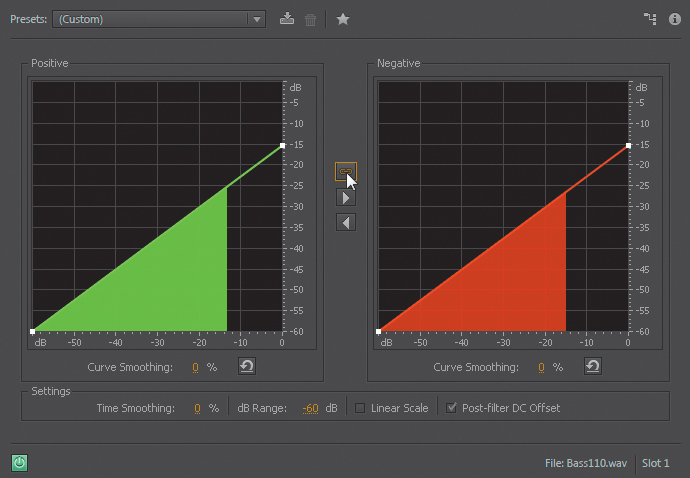
5. With the bass file playing, click the white square in the upper-right corner of a graph’s curve. Drag it down to -15 or so, and you’ll hear the sound become more distorted as you lower the level where the signal clips. Because more clipping leads to lower levels, you’ll need to increase the Effects Rack’s Output control to compensate.
6. You can boost lower levels so that they distort more readily. Click at the intersection of the two -30 levels on the X and Y axes. This creates a new node on the curve; you’ll hear more distortion.
7. Drag this new node up to increase the volume of low-level signals, thus creating more distortion. Dragging the node to the left also increases distortion by allowing lower levels to distort.
8. To remove a node, right-click (Control-click) on it. Continue adding and moving nodes to hear how this affects the sound. When there are multiple nodes, you can smooth the curve that incorporates them by increasing the Curve Smoothing parameter value.
Note
Regarding the other Distortion parameters, dB Range changes the range covered by the graph and limits possible distortion settings to the selected range. Linear scale changes the calibration; logarithmic more closely approximates the way the ear responds. Leave Post-Filter DC Offset selected because it can prevent the addition of a constant offset that can lead to clicks when editing. There’s no disadvantage to leaving it on.
9. Click a graph’s reset button (the spiral arrow). If the graphs are still linked, you’ll reset them both simultaneously; otherwise you’d need to reset them individually. With the graphs unlinked, bring the upper-right square for one of the graphs down to -20dB. This adds crunch but also preserves the “fullness” of the bass by leaving one set of peaks alone.
10. The Time Smoothing parameter changes the distortion’s reaction time to level changes, particularly at lower frequencies. Increase Time Smoothing, and the distortion becomes smoother and less harsh. Choose a value of 30%, and then bypass/enable the distortion to compare the distorted and undistorted sound. Note how the smoothing creates a softer kind of distortion quality that gives the bass a bit of “snarl” but still sounds musical. Processing a bass with a hint of distortion can help it stand out more in a mix.
Vocal Enhancer
The Vocal Enhancer effect is one of Audition’s easiest effects to use because it has only three options.
1. If Audition is open, close it without saving to start fresh. Open the program, choose File > Open, navigate to the Lesson04 folder, and open the file NarrationNeedsHelp.wav. Play the file.
2. Click the right arrow of an effect’s insert, and choose Special > Vocal Enhancer.
3. Click Male to reduce the low end somewhat to minimize p-popping and booming; note that it also helps even out the level variations a bit.
4. Load the file Drum+Bass+Arp110.wav, and insert the Vocal Enhancer in the Effects Rack. Select the Vocal Enhancer’s Music option.
5. Bypass the Vocal Enhancer. You’ll hear that the music is brighter, which could potentially interfere with vocal intelligibility. Enabling the Vocal Enhancer’s Music option creates more “space” for voice-over.
Tip
Because there aren’t any Voice Enhancer variable parameters, simply try the different options with voice (or background music in the case of the Music setting), and if it does not sound better, simply remove the effect.
6. With the same file playing, click the Male and Female options. You’ll hear how this affects music, which makes the changes in frequency response more obvious.
Guitar Suite
The Guitar Suite is a “channel strip” that emulates a guitar signal processing chain. It includes four main processors, each of which can be bypassed or enabled individually:
• Compressor. Because guitar is a percussive instrument, many guitar players use compression to even out the dynamic range and produce more sustain.
• Filter. This shapes the guitar’s tone.
• Distortion. This is a “condensed” version of the Distortion processor and offers three popular distortion types.
• Amplifier. A large part of a guitar’s sound is the amplifier through which it plays: The number of speakers and the size of each, as well as the cabinet, have a major effect on the sound. Fifteen types are available, including a cabinet for bass guitar.
However, Guitar Suite is useful for more than guitars—you’ll also apply this versatile effects suite to drums.
1. If Audition is open, close it without saving to start fresh. Open the program, choose File > Open, navigate to the Lesson04 folder, and open the file Guitar.wav. Play the file.
2. Click the right arrow of an effect’s insert, and choose Special > Guitar Suite.
3. Call up the preset Big and Dumb, which makes a great start for a classic rock guitar sound.
Tip
Many guitar sounds use distortion. However, you want to avoid unintentional distortion caused by overloading within Audition and use only the intentional distortion created by the Guitar Suite processor. Guitar processors can cause wide level swings, so pay close attention to the Effects Rack panel’s Input and Output controls to make sure they don’t go into the red zone.
4. Vary the Compressor Amount slider. The sound will be more percussive to the left and more sustained (with a slight volume drop) to the right. Set the Amount to 70 before proceeding.
5. Vary the Distortion Amount slider. The sound is “cleaner” to the left and “dirtier” to the right. Try the three different distortion types from the Distortion Type drop-down menu, and vary the Amount slider. Garage Fuzz is more punk, Smooth Overdrive more rock, and Straight Fuzz emulates the sound of a distortion effect box rather than an amp. Return to Smooth Overdrive, and set the slider to 90.
6. That sound seems a little harsh, but you can make it smoother with the filter. Deselect the Filter bypass check box.
7. Move the Freq slider to around 1500Hz with Resonance at 0. This removes some of the “edge.” Note how increasing Resonance makes the sound “sharper.” Leave Resonance at 0 for now.
8. To hear how different amplifiers affect the sound, choose various options from the Amplifier Box drop-down menu—Classic British Stack, Classic Warm, 1960s American, 1970s Hard Rock, and Deep 4×12 are some of the most realistic emulations. Also note that there are six non-amp and special FX sounds. Bypassing the Amplifier emphasizes just how much speakers and cabinets influence the tone.
9. Return to the Big and Dumb preset, but choose Classic British Stack for the Amplifier Box parameter. Deselect the Filter bypass check box.
10. The Filter precedes the Distortion section. Therefore, reducing signal levels due to filtering will result in less distortion. Often, this is the sound you want, but if you feel the overall level is too low, move the Distortion Amount slider to the right to compensate.
11. With Retro selected as the Filter, choose Bandpass for the Type (this is like a Parametric EQ stage without the boost/cut control). For a big, metal sound, set Freq to around 435Hz and Resonance to 20 to produce a little response peak at that frequency.
12. You’ve already worked with Lowpass and Highpass filters in previous sections on equalizers (Lowpass reduces highs; Highpass reduces lows); Resonance is equivalent to the Q control you used with some of the equalizers. Feel free to experiment at this point, but if you’re impatient to discover some other filter types, proceed to the next step.
13. Choose Rez as the Filter and Bandpass as the Type (the other responses work too, but these produce the most obvious effect), and set Resonance to 0. Vary the Freq slider, and you’ll hear a resonant effect like a wah pedal. Turn up Resonance if you really want to go overboard.
14. Each of the remaining five filters has a fixed frequency that corresponds roughly to the mouth’s filtering effect when forming various vowels. Change the Freq slider position; note that this doesn’t change the TalkBox filter frequency per se but acts more like a “window” that sweeps across the filter frequency, making it more or less prominent.
15. Load the TalkBox U filter and select Bandpass for Type. With Resonance at 0, move the Freq slider across its range. The peak level will be around 1kHz; moving the Freq slider to either side reduces the level somewhat and also changes the timbre.
16. The Guitar Suite is also suitable for other instruments, particularly drums. Choose File > Open, navigate to the Lesson04 folder, and open the file Drums110.wav.
17. Click the right arrow of an effect’s insert, and choose Special > Guitar Suite. Load the Big And Dumb preset.
18. Enable the Filter, and move the Freq slider to around 3000Hz. Set Resonance to 20%.
19. Although you’ll hear a good “trash” drum sound, you can tame it by moving the Mix Amount slider to the left (try 30–40%). This adds the dry drum sound in with the “trash” sound so that the overall sound is more defined.
Mastering
Mastering is another effects “suite.” Adobe Audition already excels at mastering, so including a Mastering suite may seem redundant. However, it provides a quick way to master material that doesn’t require creating an à la carte set of mastering processors.
The suite includes the following effects:
• Equalizer. Includes a low shelf, high shelf, and parametric (peak/notch) stage. Its parameters work similarly to the same parameters in the Parametric Equalizer effect. The Equalizer also includes a real-time graph in the background that shows the current frequency response spectrum. This helps with making EQ adjustments; for example, if you see a huge bass “bump” in the low end, the bass probably needs to be reduced.
• Reverb. Adds ambience if needed.
• Exciter. Creates high-frequency “sparkle” that’s unlike conventional treble-boosting EQ.
• Widener. Allows for widening or narrowing the stereo image.
• Loudness Maximizer. Is a dynamics processor that increases the average level for a louder sound without exceeding the available headroom.
• Output Gain. Can be adjusted to control the effect output and therefore compensate for any level changes due to adding various processes.
You’ll use the Mastering Suite to give greater clarity to a piece of music.
1. If Audition is open, close it without saving to start fresh. Open the program, choose File > Open, navigate to the Lesson04 folder, and open the file DeepTechHouse.wav. Play the file. Note that there are two problems: The bass “booms” a bit too much, and the high end lacks definition.
2. Click the right arrow of an effect’s insert, and then choose Special > Mastering.
3. Call up the preset Subtle Clarity. Toggle the power button to enable/bypass the preset’s effect; note how this indeed produces more clarity.
4. You’ll now fix the bass. Select Low Shelf Enable; a small X appears toward the left, which you click on and drag to change the shelf characteristics. Resume playback.
5. Drag the Low Shelf marker right to around 240Hz. Then drag down to about -2.5dB. Enable/bypass the Mastering effect, and you’ll hear that when Mastering is enabled, the low end is tighter and the high end is more defined.
6. The Reverb is not intended to provide big hall effects but adds ambience when used subtly. It’s set to 20% in the preset; move it left to 0%, and the sound will be a little “dryer.” A value of 10% seems to work well for this tune.
7. Most of the preset’s additional “clarity” is due to the slight upper midrange boost around 2033Hz working in conjunction with the Exciter, which affects the highest frequencies. A little bit of Exciter effect goes a long way. Drag its slider to the right, and the sound will become way too bright. Because the song is already fairly bright, disable the Exciter effect by dragging its slider all the way to the left. (Note that the sonic difference among the three characters of Retro, Tape, and Tube becomes most noticeable with dull material and high Exciter amounts.)
8. Adjust the Widener to taste; end on a setting around 60.
Tip
It might seem logical to set the Widener for the widest possible stereo image to create a more dramatic sound. However, emphasizing the extreme left and right areas of the stereo spectrum can deemphasize the center, thus unbalancing a mix. If you listen closely and move the slider between 0 and 100, you’ll usually find a “sweet spot” that provides maximum width without altering the mix’s fundamental balance.
9. The Loudness Maximizer can increase the apparent loudness for a more “punchy” sound. However, as with the Exciter, you can have too much of a good thing. Excessive maximization can lead to ear fatigue, as well as make the music less interesting by reducing dynamics. For this song, set it to 30 to provide a useful boost without adding a distorted or unnatural sound.
10. Because the Loudness Maximizer will prevent the level from exceeding 0, you can leave the Output Gain at 0.
11. Toggle the power button to enable/bypass the effect and listen to the difference. The mastered version has more sparkle, the bass is in proper proportion with respect to level, the stereo image is wider, and there’s been a subjective overall level boost.
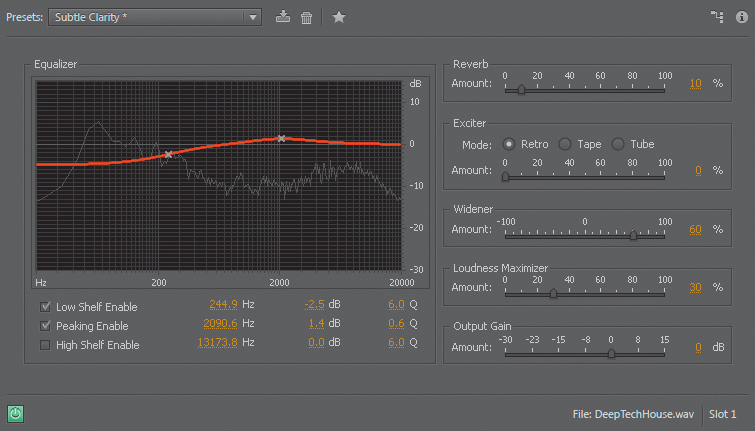
Stereo imagery effects
Stereo imagery effects alter a file’s stereo image. Audition includes two effects for altering stereo image: a Center Channel Extractor and a Graphic Phase Shifter. The latter is a very esoteric tool that you will likely not need to use when doing typical audio projects, so we’ll cover only the Center Channel Extractor. For further information on either effect, refer to the Help files.
Center Channel Extractor
With stereo signals, some sounds are traditionally mixed to center—particularly vocals, bass, and kick drum. Reversing the phase of one channel cancels out any material panned to center while leaving signals panned left and right alone. This is commonly used for karaoke to remove the vocal. By filtering the channel that’s out of phase to emphasize voice frequencies, bass and kick aren’t affected that much.
However, Audition’s Center Channel Extractor is a very sophisticated implementation of this principle that allows for boosting or cutting the center channel, as well as includes precise filtering to help avoid applying the effect where it’s not wanted.
1. If Audition is open, close it without saving to start fresh. Open the program, choose File > Open, navigate to the Lesson04 folder, and open the file DeepTechHouse.wav. Don’t start playback yet.
2. Click the right arrow of an effect’s insert, and choose Stereo Imagery > Center Channel Extractor.
3. Call up the preset Boost Center Channel Bass, but turn down the monitoring level because the bass will be pretty loud.
4. Start playback and slowly turn up the monitoring level. The bass will be excessively loud, and you’ll need to pull back on the Effects Rack panel’s Output control to around -7dB to avoid distortion.
5. Pull the Center Channel Level control down all the way, and the bass will essentially disappear.
6. Return the Center Channel Level control to 0. Pull the Side Channel Levels control down all the way to isolate the bass.
The next lesson isolates vocals.
1. Choose File > Close. Don’t save any changes.
2. Choose File > Open, navigate to the Lesson04 folder, and open the file ContinentalDrift.wav. Don’t start playback yet.
3. Click the right arrow of an effect’s insert, and choose Stereo Imagery > Center Channel Extractor.
4. Call up the preset Vocal Remove. Start playback around 32 seconds. The lead vocals extend to about 47 seconds, but you won’t hear them because they’re being removed (around 45 seconds you’ll hear some backup vocals that aren’t removed because they aren’t panned to center).
5. Return to around 32 seconds and start playback. Bring up the Center Channel Level to hear the vocals.
6. You can access several real-time adjustments via the Discrimination tab. Choose the highest possible Crossover Bleed settings and the lowest possible Phase Discrimination, Amplitude Discrimination, and Amplitude Bandwidth settings that are consistent with sound quality and effectiveness. Increasing the Spectral Decay Rate will often improve sound quality as well.
You’ve now learned the highlights of the Center Channel Extractor; refer to Audition’s Help file for more details on this relatively esoteric effect.
Note
Sample Magic produces the Deep Tech House sample library, whereas the Continental Drift sample library is made by Sony. These illustrate the range of music you can create from commercially available sample and loop libraries.
Time and Pitch effect
The sole effect under the Time and Pitch effect, Automatic Pitch Correction, is designed for vocals and corrects the pitch of notes so that they are in tune. However, be careful when applying this effect; many vocalists deliberately sing some notes a little flat or sharp to add interest or tension to a vocal; correcting these can remove a vocal’s “human” quality.
Automatic Pitch Correction
Pitch correction is intended for vocals whose pitch is slightly out of tune. This effect analyzes the vocal to extract the pitch, calculates how far off a note is from the correct pitch, and then corrects the note by raising or lowering the pitch to compensate.
1. If Audition is open, close it without saving to start fresh. Open the program, choose File > Open, navigate to the Lesson04 folder, and open the file OriginalVocal.wav. Don’t start playback yet.
2. Click an effect insert’s right arrow, and choose Time and Pitch > Automatic Pitch Correction.
3. Bypass the Automatic Pitch Correction effect, and start playback. Observe the correction meter on the right: The red band indicates how far off the pitch is from the ideal. When the meter moves up, the pitch is sharp. When the meter moves down (see screen shot), the pitch is flat. A centered meter indicates that the vocal is on pitch.
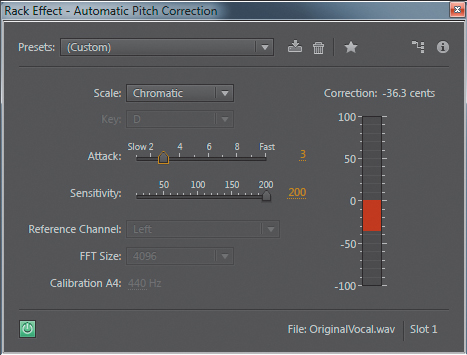
Note
When a vocal has vibrato, the pitch will go somewhat sharp and flat periodically. This is normal and usually desirable; you can adjust the Automatic Pitch Correction to leave natural vibrato uncorrected.
4. The Scale and Key options define the notes to which pitch should be corrected. For example, with a C major scale, the notes will be corrected to C, D, E, F, G, A, and B. However, to use this option, you need to know a vocal’s correct scale and key; choose these from the Scale and Key drop-down menus. If you do not know the Scale and Key choose Chromatic from the Scale drop-down menu, which simply corrects to the nearest semitone. (The vocal is in D but uses a flatted 7th note that is not part of the major scale. So, choose Chromatic instead.) In most cases, Chromatic will do the job.
Note
As for the remaining Automatic Pitch Correction parameters, Reference Channel is useful only with stereo files. It chooses the channel from which the pitch profile should be calculated. FFT size trades off more accuracy (larger numbers) for faster response (smaller numbers). Calculation A4 sets the frequency in Hertz for the note A. In the United States 440 is the standard, but this can be different in other countries and with some types of music.
5. Set the Sensitivity slider to 200 to correct all notes. At lower Threshold settings, notes that are off-pitch by more than the pitch threshold will be unaffected.
6. Start playback with Automatic Pitch Correction still bypassed. It’s a good idea to loop this example so you don’t have to keep clicking Play. Listen for a few iterations of the loop, and then enable the effect.
7. Note how all the notes are on pitch. To compare, either bypass the effect or move the Sensitivity Fader to 0.
8. Move the Attack slider to 10. This produces the fastest response, so the Automatic Pitch Correction will attempt to pitch-correct the vibrato. You’ll hear a warbling sound, so use a slow enough setting to allow the vibrato to change pitch naturally. A setting of 2 to 4 is a good compromise between correcting pitch rapidly on sustained notes but not affecting vibrato.
9. Change the scale to Minor and Key to D. You’ll hear the vocal take on a more minor quality as notes are shifted to the appropriate pitches for a minor scale.
Third-party effects (VST and AU)
In addition to using Audition’s effects, you can load effects (plug-ins) made by other manufacturers. Audition is compatible with the following formats:
• VST (Virtual Studio Technology) is the most common Windows format and is also supported by the Mac. However, you need separate plug-in versions for Mac and Windows. For example, you can’t buy a particular VST plug-in for the Mac and use it with Windows.
Note
Both Windows and Mac offer 64-bit operating systems (Windows Vista and 7, Mac OS X Lion and Mountain Lion), which can use 64-bit versions of plug-ins. Although Audition can run on 64-bit operating systems, it is a 32-bit application and is not compatible with 64-bit plug-ins on either Mac or Windows. However, very few plug-ins are 64-bit only; almost all are available in 32-bit versions that are compatible with Audition CS6.
• VST3 is an updated version of VST2 that offers more efficient operation and other general improvements. Although not quite as common as standard VST, it’s gaining in popularity.
• AU (Audio Units) is Mac-specific, was introduced with OS X, and is the most popular and common format for the Mac.
On either platform, plug-ins are installed in specific hard drive folders. You need to let Audition know where to find these plug-ins. The information in the following sections applies to both Windows and Macs unless otherwise specified.
The Audio Plug-In Manager
Audition’s Audio Plug-In Manager provides several functions:
• It scans your computer for plug-ins so Audition can use them and creates a list showing the name, type, status, and file path (where the plug-ins are located on your computer).
Note
Many free, legal plug-ins in a variety of formats are available on the Internet. These range from poorly coded effects made by beginning programmers to plug-ins that are every bit as good—and sometimes better—than commercially available, professional products.
• It allows you to specify additional folders that contain plug-ins, and then re-scan these added folders. Most plug-ins install to default folders, and Audition scans these folders first. However, some plug-ins may install into a different folder, or you might want to create more than one folder of plug-ins.
• It lets you enable or disable plug-ins.
When you first open Audition, you’ll need to tell it to scan for plug-ins before they can be used in a project.
1. From the Effects option in the menu bar, choose Audio Plug-In Manager.
2. Click Scan for Plug-Ins. Audition must inspect your hard drive, so this can take a while.
When scanning is complete, you’ll see the plug-in listing and status, which usually indicates the manager is done. However, if needed, also complete the following steps.
3. To add an additional folder with plug-ins, click Add and navigate to the folder.
4. To enable or disable a particular plug-in, select the check box to the left of the plug-in’s name.
5. To re-scan the existing plug-ins, click Re-Scan Existing Plug-Ins.
Note
Although rare, some plug-ins may be incompatible with Audition. This could be due to a nonstandard implementation, an older plug-in that was not updated, a bug within the plug-in that shows up only with particular programs, or a proprietary plug-in that’s not intended to work universally. If Audition encounters a plug-in it cannot load, the scanning process stops. If scanning doesn’t resume after a minute or so, click Cancel. Audition will enter the incompatible plug-in in the list of plug-ins, but it will be disabled. Run the scan as many times as necessary until the process completes.
Note that you can enable or disable all plug-ins by clicking the appropriate button.
6. When you’re finished with the Audio Plug-In Manager, click OK.
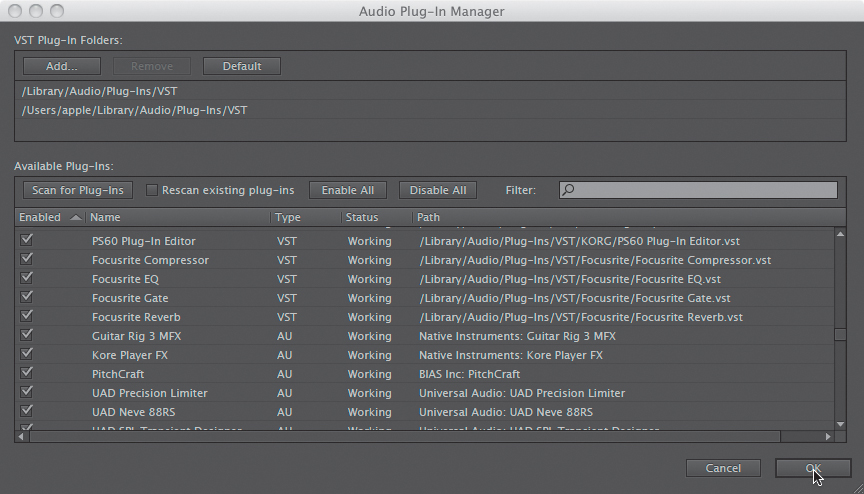
Using VST and AU plug-ins
VST and AU plug-ins appear as part of the same drop-down menu that opens when you click an Effects Rack insert’s right arrow. For example, with Windows you’ll see entries for VST and VST3 effects along with the other entries for Modulation, Filter and EQ, Reverb, and the like; the Mac adds another entry for AU effects. Here’s how to use these effects in Audition.
1. Click an Effects Rack insert’s right arrow.
2. Choose the entry (VST, VST3, or on the Mac, AU) containing the effect you want to insert.
3. Click the effect you want to insert, as you would with any of the effects included with Audition.
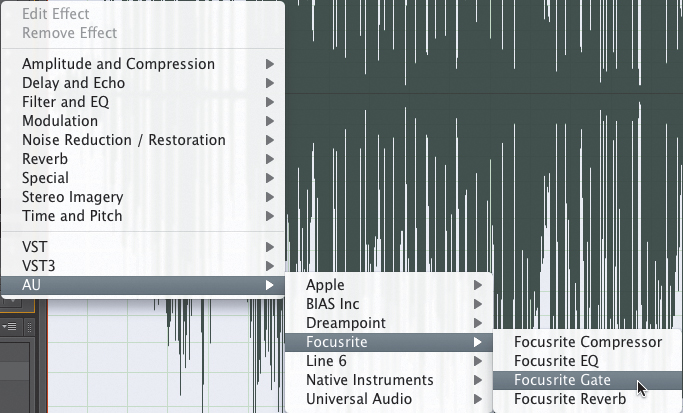
Using the Effects menu
You can process any audio selected in the Waveform or Multitrack Editor by choosing the desired effect from the Effects menu. Unlike with the Effects Rack, you can apply only one effect at a time.
This section covers effects that are available only from the Effects menu. Any effects you can also access from the Effects Rack work the same way when opened from the Effects menu with three exceptions:
• The Invert, Reverse, and Silence effects are applied to the audio as soon as you select them. You can use the Undo command to undo the effects.
• Most effects chosen via the effects categories (Amplitude and Compression, Delay and Echo, etc.) have an Apply and a Close button. Clicking Apply applies the effect to the selected audio.
• Unlike the Effects Rack, editing is destructive (although the changes aren’t made permanent unless and until the file is saved). However, you can still audition any changes before applying them, because most effects chosen via the effects categories have a Play and Loop button to the right of the effect’s power on/off button. Loop repeats the selected portion of the audio when you click Play.
Invert, Reverse, and Silence effects
Invert changes the signal’s polarity (commonly called phase) and produces no audible difference. Reverse flips an audio selection so that the beginning occurs at the end and the end at the beginning. Silence replaces the selected audio with silence.
1. If Audition is open, close it without saving to start fresh. Open the program, choose File > Open, navigate to the Lesson04 folder, and open the file NarrationNeedsHelp.wav.
2. Play the file to hear what it sounds like, and then select the part at the beginning that says, “Most importantly, you need to maintain good backups of your data.”
3. Choose Effects > Invert. Note that the positive and negative sections are flipped, so the positive peaks are now negative and vice versa. However, if you play this, you’ll hear no audible difference.
4. Choose Effects > Reverse. Play back the selection, and you’ll hear reversed speech.
5. Select the same section. Choose Effects > Silence to convert the audio to silence.
6. Close the File without saving it, but leave Audition open.
Additional Amplitude and Compression effects
Three Effects menu functions are not available with the Effects Rack: Normalize, Fade Envelope, and Gain Envelope.
1. Choose File > Open, navigate to the Lesson04 folder, and open the file Bass110.wav.
2. Select a single bass note, and choose Effects > Amplitude and Compression > Normalize (process).
Note
You can show the peak as either a percentage of the signal or the level in dB, referenced to the maximum available headroom. For example, if you select the dB radio button, 25% normalization is equivalent to a peak that reaches -12dB. Normalize All Channels Equally treats the peaks for both channels similarly, and DC Bias Adjust ensures that a level of 0 is truly a value of 0. There’s no practical reason not to select this option.
3. Normalization adjusts a selection’s level so that its peak (highest level) attains a particular percentage of the overall level. Set Normalize to 25% and click OK; the note’s peak will reach 25% of the maximum available level.
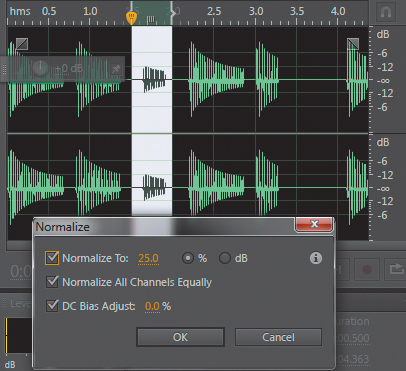
4. Choose Edit > Undo or press Ctrl+Z (Command+Z) to restore the bass note to its previous level.
5. Select the right half of the waveform (the first three notes), and choose Effects > Amplitude and Compression > Fade Envelope (process).
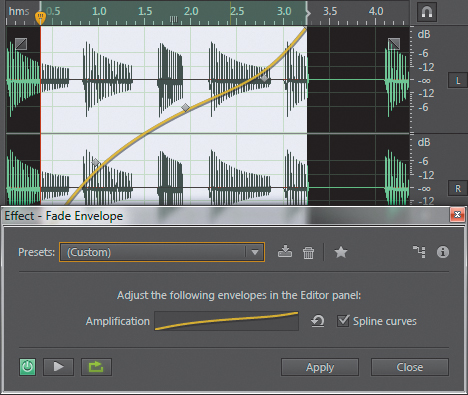
6. Load the Linear Fade In preset. A line that indicates amplitude appears superimposed on the selection. Play the file, either by clicking the Fade Envelope dialog box’s Play button or by pressing the spacebar, and you’ll hear the bass notes fade in.
7. You can adjust the fade shape by clicking on the line to create new nodes, as you did toward the end of Lesson 3, “Basic Editing.” A thumbnail in the Fade Envelope dialog box shows the shape; select the Spline Curves check box to round the fade line.
8. Select a different region. The curve now adapts to fit within the selection. Regardless of the size of the selection, the curve adapts proportionally to fit.
9. Click Close in the Fade Envelope dialog box without applying the fade.
10. Select part of the waveform, and choose Effects > Amplitude and Compression > Gain Envelope.
11. Select +3dB Hard Bump. A line that indicates amplitude appears superimposed on the selection. You can adjust the gain curve shape by clicking on the line to create new nodes, and as with the fade, a thumbnail in the Gain Envelope dialog box shows the shape. If desired, select the Spline Curves check box to round the fade line.
12. Select a different region. As with the Fade Envelope, the curve adapts to fit within the selection.
Diagnostic effects
Diagnostic effects will be covered in Lesson 5 along with the real-time, nondestructive noise reduction and restoration tools. The Diagnostic effects produce the same sonic results but are destructive, DSP-based processes.
Doppler Shifter effect
The Doppler Shifter effect is an unusual effect that changes pitch and amplitude to make signals sound “three dimensional” as they circle around you, whiz by from left to right, and do other effects that alter spatial placement.
1. If Audition is open, close it without saving to start fresh. Open the program, choose File > Open, navigate to the Lesson04 folder, and open the file FemaleChoir.wav.
2. Choose Effects > Special > Doppler Shifter. Click the dialog box’s Play button to hear the default effect. Like all of the Doppler Shifter presets, this effect is particularly dramatic on headphones.
3. Choose various presets. You may need to stop and restart Play between presets.
4. The best way to understand how this effect works is to choose a Path Type (straight or circular), and then vary the parameters to hear how changes to specific parameters affect the sound. Take a few moments to do this now. You can get some really wild effects with this processor; note that you may need to stop and restart Play with major edits.
5. When you’re finished, close Audition without saving the file.
Manual Pitch Correction effect
The Manual Pitch Correction effect is one of two Time and Pitch effects that are available only from the Effects menu.
1. If Audition is open, close it without saving to start fresh. Open the program, choose File > Open, navigate to the Lesson04 folder, and open the file Drum+Bass+Arp110.wav.
2. Choose Effects > Time and Pitch > Manual Pitch Correction. The Waveform Editor changes to Spectral view, and the Manual Pitch Correction dialog box appears. Play the file as a reference.
3. The HUD has an additional control for pitch along with the standard volume control. Click on this control and drag down to lower pitch; drag up to raise pitch. For now, drag down to -200 cents (2 semitones). A yellow line superimposed on the Waveform overview shows the amount of pitch change.
4. Click Play to hear the sound transposed down to a lower pitch.
5. Drag the HUD so it’s not on top of the yellow line. Click on the yellow line to create a node, which you can drag up or down to further change pitch. As with other Audition envelopes, you can insert multiple nodes and make complex curves, as well as round them off by selecting the Spline curves check box.
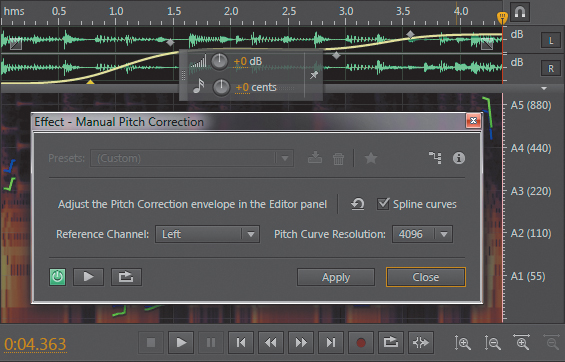
Note
The Pitch Curve Resolution parameter trades off better accuracy (higher numbers) for faster response and lower CPU loading (lower numbers). For the Reference Channel, try both options and use whichever produces the highest-quality sound.
6. Click Close without applying the effect. Leave Audition open for the next lesson.
Stretch and Pitch effect
The Stretch and Pitch effect is the other Time and Pitch effect that’s available only from the Effects menu. It offers high-quality time and pitch stretching.
1. Assuming the Drum+Bass+Arp110.wav file is still open, choose Effects > Time and Pitch > Stretch and Pitch.
2. The default preset changes neither time nor pitch. Set the Stretch slider to 200%, click the dialog box’s Loop button, and then click Play. The file will now play at half speed.
3. Set the Stretch slider to 50%, and then click Play. The file now plays at double-speed. After auditioning this change, reset the Stretch fader to 100%.
4. Vary the Pitch Shift slider and note how this affects the sound. There’s a slight delay before any pitch change takes effect, because Audition has to do a lot of calculations. You can shorten this time by selecting a level of Precision other than the default setting of High.
5. Select Lock Stretch and Pitch Shift. This links the two parameters so that if, for example, you shift pitch up an octave, the speed doubles; shifting pitch down an octave halves the speed. For an interesting “slowdown” effect, set Stretch to 100%. Click Play, and then slowly move the Stretch slider to the right. With Stretch and Pitch Shift still locked, return the Stretch slider to 100% before proceeding.
6. You can also use the Stretch effect to change a file’s length. For example, the current file is 4.363 seconds long. Suppose it needs to be 5.00 seconds long. Select the Lock Stretch Settings to New Duration check box, and enter 5.00 for the New Duration parameter. Click Play; now the loop is exactly 5.00 seconds long.
7. Because the stretch settings are locked to duration, the pitch will be somewhat lower because the file is longer. To preserve the pitch, deselect Lock Stretch Settings to New Duration, make sure Lock Stretch and Pitch Shift aren’t selected, and then set Pitch Shift to 0 semitones. When you’re finished, close Audition without saving the file.
Note
There are two algorithm choices in the Stretch and Pitch window, iZotope Radius and Audition. The Audition algorithm is less CPU-intensive, but the Radius algorithm has much better fidelity, and most modern computers will have no problem handling the extra CPU load.
8. The Advanced parameters are mostly important when manipulating voice; make sure the Solo Instrument or Voice and Preserve Speech Characteristics check boxes are selected, and adjust the Pitch Coherence slider for the best sound quality (this will be subtle). You can try deselecting Solo Instrument or Voice and Preserve Speech Characteristics with audio other than voice, but you may not hear much difference.
9. Click Close.
Managing presets
When you create a particular effect you like, or even a complete Effects Rack configuration with multiple effects, you can save it as a preset for later recall. The preset header is similar for both individual effects and the Effects Rack.
Create and select a preset
Here’s how to create and save a preset for the Amplify effect that boosts gain by +2.5dB.
1. Open Audition, navigate to the Lesson04 folder, and open any audio file you’d like.
2. Choose Effects > Amplitude and Compression > Amplify. Enter +2.5dB in the Left and Right Gain numeric fields.
3. Click the Save Settings as a Preset button to the right of the Presets field. A Save Effect Preset dialog box appears.
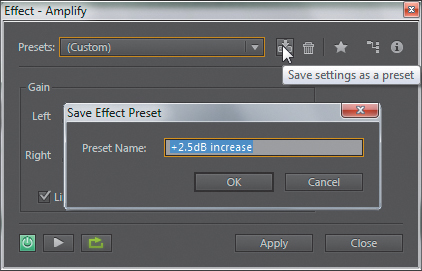
4. Enter a name for the preset, such as +2.5dB increase, and click OK. The preset name will then appear in the list of presets.
Delete a preset
To delete a preset, select it, and then click the Trash Can button to the right of the Save Settings as a Preset button.
Create and select a favorite
If you create a preset you expect to use a lot, you can save it as a favorite.
1. When the preset settings are as desired, click the star button toward the upper-right corner of the effect window.
2. Name this favorite preset in the dialog box that appears.
3. Click OK.
4. To access the favorite, select the audio you want to process, choose Favorites, and then select your favorite to apply the preset settings immediately to the selected audio.
Review questions
1. What are the advantages of the Effects Rack, the Effects menu, and Favorites?
2. Is it possible to expand the roster of effects available to Audition?
3. Why is “gain-staging” important with the Effects Rack?
4. What is the difference between “dry” and “wet” audio?
5. What is the name of the process that allows for transposing pitch or lengthening/shortening files?
Review answers
1. The Effects Rack allows you to make complex effects chains, the Effects menu includes additional effects and can apply single effects rapidly, and the Favorites presets can apply settings to audio immediately upon choosing the preset.
2. Audition can load third-party VST, VST3, and for the Mac, AU effects as well.
3. Effects can increase gain, thus causing distortion within the Effects Rack. By adjusting levels going into and out of the rack, it’s possible to avoid distortion.
4. Dry audio is unprocessed, whereas wet audio has been processed. Many effects let you alter the proportion of the two types of audio.
5. The processes are called high-quality time- and pitch-stretching, respectively.
